
About UsThe Numismatic Bibliomania Society is a non-profit organization devoted to the study and enjoyment of numismatic literature. For more information please see our web site at coinbooks.org SubscriptionsThose wishing to become new E-Sylum subscribers (or wishing to Unsubscribe) can go to the following web page link MembershipThere is a membership application available on the web site Membership Application To join, print the application and return it with your check to the address printed on the application. Membership is only $20 to addresses in the U.S., $25 for First Class mail, and $30 elsewhere. For those without web access, write to: David M. Sundman, Treasurer
AsylumFor Asylum mailing address changes and other membership questions, contact David at this email address: dsundman@LittletonCoin.com SubmissionsTo submit items for publication in The E-Sylum, just Reply to this message, or write to the Editor at this address: whomren@gmail.com BUY THE BOOK BEFORE THE COINSale Calendar |
- WAYNE'S WORDS: THE E-SYLUM JUNE 14, 2015
- NEW BOOK: ENCYCLOPEDIA OF MEXICAN MONEY, VOL 2
- NEW BOOKS IN THE MONETA SERIES: #188-190
- NEOCOLLECT WEB SITE SHUTS DOWN
- LAUBENHEIMER FAMILY ARCHIVES IN JUNE 25, 2015 SALE
- SARAH SOPHIA BANKS AND THE ‘CONTINENTAL DOLLAR' OF 1776
- SUBSCRIBER PROFILE: DON AND LOIS BAILEY
- AUTHOR REBUTS MISPLACED NATIVIST CRITICISM
- DESIGNING THE AMERICAN FIGHTER ACES MEDAL
- ATLAS OBSCURA LOOKS AT 1896 EDUCATIONAL SERIES NOTES
- MYSTERY MEDALET ATTRIBUTED TO THE NETHERLANDS
- NOTES FROM E-SYLUM READERS: JUNE 14, 2015
- MORE ON THE KALAUPAPA LEPER COLONY
- OREGON TRAIL HALF DOLLAR: OBVERSE AND REVERSE
- MORE RESEARCH ON THE EVERMAN COUNTERSTAMP
- QUERY: WHY ARE FAMOUS NAMES USED ON OBSOLETE BANKNOTES?
- WHERE DID COPPER ORE FOR THE US MINT COME FROM?
- CHEVALIER'S COMMENTS ON U.S. GOLD COIN USAGE
- SARAH ANN PROUT EMANCIPATION DAY TOKEN
- SOME ODD TOKEN CONCOCTIONS
- THE JOHN WANAMAKER MEMORIAL MEDAL
- WILLIAM BUTLER YEATS COIN LAUNCH CEREMONY
- ON MUTED, PICTORIAL AND MINIMALIST COIN DESIGNS.
- FALUN GONG OVERSTAMPED NOTES CIRCULATING IN CHINA
- BANK OF ENGLAND CHIEF CASHIER VISITS STUDENTS
- WAYNE'S NUMISMATIC DIARY: JUNE 14, 2015
- THE PARADOX OF BYZANTINE SILVER
- THE SESTRORETSK AND PUGACHEV RUBLES
- SOUTH KOREA'S 1975 LIBERATION COMMEMORATIVE COIN
- BELGIUM DEFIES FRANCE WITH WATERLOO COIN ISSUE
- RESEARCHER CLAIMS NAZI GOLD LOOTED BY AMERICAN TROOPS
- MORE ON THE ONE-CENT MAGENTA STAMP
- MEDALS ON STAMPS
- ZIMBABWE COMPLETING PHASING OUT OF ITS OLD CURRENCY
- THE 1950 PAKISTAN 100 RUPEES HAJ NOTE
- SELECTIONS FROM THE SPINK WORLD BANKNOTES SALE
- MORE SELECTIONS FROM PRESIDENTIAL AUCTION #85
- OLD SAN FRANCISCO MINT BUILDING ATTRACTS HOMELESS
Click here to access the complete archive
To comment or submit articles, reply to whomren@gmail.com
WAYNE'S WORDS: THE E-SYLUM JUNE 14, 2015

New subscribers this week include: Kevin Flavin. Welcome aboard! We now have 1,846 subscribers. Due to a technical problem with our mailing service, the email version of this issue was published Monday evening, but the online version was published normally and available Monday morning, as usual. Sorry for the inconvenience.
This week we open with four new books and an update on the NeoCollect web site. Other topics include the Laubenheimer archive, the Continental Dollar, Joel Iskowitz' Fighter Aces medal design, the Oregon Train half dollar, gold coin usage in the 1830s, muted, pictorial and minimalist coin designs, Falun Gong notes, the Pakistan Haj note, and the paradox of Byzantine silver.
To learn more about A.C. Paquet's Business Card, Don Bailey, famous names on obsolete banknotes, an Emancipation Day token, Belgium's new Waterloo coin, copper isotope fractionation, starving billionaires and the Perpetual Dictator of the Order of the Honey Bee, read on. Have a great week, everyone!
Wayne Homren
Editor, The E-Sylum
NEW BOOK: ENCYCLOPEDIA OF MEXICAN MONEY, VOL 2
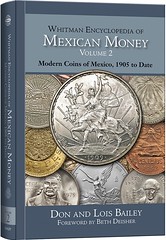 Whitman Publishing announces the release of the second volume of the Whitman Encyclopedia of
Mexican Money, by Don and Lois Bailey. The 480-page hardcover book debuts June 30, 2015. It will be available from booksellers and
hobby shops nationwide, and online (including at www.Whitman.com), for $39.95. The book can also be borrowed for free as a benefit of
membership in the American Numismatic Association, through the Dwight N. Manley Numismatic Library.
Whitman Publishing announces the release of the second volume of the Whitman Encyclopedia of
Mexican Money, by Don and Lois Bailey. The 480-page hardcover book debuts June 30, 2015. It will be available from booksellers and
hobby shops nationwide, and online (including at www.Whitman.com), for $39.95. The book can also be borrowed for free as a benefit of
membership in the American Numismatic Association, through the Dwight N. Manley Numismatic Library.
Volume 2, the second book in the four-volume Encyclopedia, covers the modern coins of Mexico in depth. These include many of the most popularly collected Mexican coins: issues of the coinage reform of 1905; the coinage reform of 1992 to date; Mint and Proof sets; silver bullion coinage (1949, 1978–1980); gold medallic coinage (1953 and 1957); gold bullion coinage (1953, 1957, 1999), including the Cultural Fusion Series of 2011; the silver, gold, and platinum Libertad series of 1982 to date; and the Pre-Columbian Collections coin programs.
Illustrated essays study the coinage emblems from the Aztec Calendar Stone, the history of design styles of the Mexican heraldic eagle, and many other cultural topics related to Mexican coinage. Other resources for collectors, dealers, and historians include bullion-value tables for common gold and silver coins; a glossary of numismatic terms; a bibliography; biographies and histories of important leaders and themes featured on Mexican coinage; and a detailed index.
The Whitman Encyclopedia of Mexican Money is written and edited by internationally recognized experts Don and Lois Bailey, with the collaboration of coin dealers, collectors, museum curators, government and bank officials, and other specialists. Richly illustrated in full color, with retail prices in multiple grades, it is the new standard reference for Mexican numismatics.
“The Whitman Encyclopedia of Mexican Money is the only series of its kind: a set of in-depth, richly illustrated, full-color history and price guides for collectors of Mexican coins—a growing field in the hobby,” says Whitman publisher Dennis Tucker.
Beth Deisher, the longtime editor of Coin World who expanded the newspaper’s coverage of Mexican numismatics starting in the 1980s, wrote volume 2’s foreword. She calls it “a must-have reference for anyone interested in collecting or investing in modern Mexican coins.”
Future volumes in the Whitman Encyclopedia of Mexican Money will focus on media of exchange from pre-Columbus days through the colonial period and Republican decimal coinage (volume 3); and the coins and tokens of the 1910–1920 Mexican Revolution (volume 4).
Whitman Encyclopedia of Mexican Money, volume 2 By Don and Lois Bailey; foreword by Beth Deisher, Editor, Coin World, 1985–2012; research editor Diana Plattner
ISBN 079483954-1 Hardcover, 6 x 9 inches, 480 pages, full color Retail $39.95 U.S
For more information, or to purchase, see:
Whitman Encyclopedia of
Mexican Money, Volume II (www.whitman.com/store/Inventory/Detail/Whitman-Encyclopedia-of-Mexican-Money-Volume-II+0794839541)
To read the earlier E-Sylum articles, see:
NEW BOOK: ENCYCLOPEDIA OF MEXICAN MONEY
(www.coinbooks.org/esylum_v17n39a02.html)
BOOK REVIEW: ENCYCLOPEDIA OF MEXICAN MONEY
(www.coinbooks.org/esylum_v17n47a09.html)
NEW BOOKS IN THE MONETA SERIES: #188-190
Latest MONETA publications (May 2015)
Documents and Studies on 19th c. Monetary History.
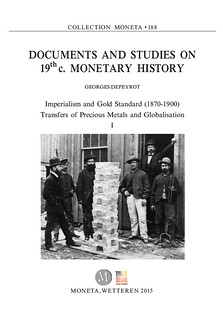 This series of volumes Documents and Studies on 19th c. Monetary History
aims to republish the main documents related to the question of bimetallism at the end of the 19th century. The series will include several
sub-series devoted to the International Monetary Conferences held in various capitals during the second half of the century and to the
specific situation of different countries (i.e. India, Japan, United States of America, China, etc.), since the question of monetary
systems was a global question. It will also include specific studies on monetary questions and on monetary history.
This series of volumes Documents and Studies on 19th c. Monetary History
aims to republish the main documents related to the question of bimetallism at the end of the 19th century. The series will include several
sub-series devoted to the International Monetary Conferences held in various capitals during the second half of the century and to the
specific situation of different countries (i.e. India, Japan, United States of America, China, etc.), since the question of monetary
systems was a global question. It will also include specific studies on monetary questions and on monetary history.
The scientific community will thus have access to the enormous collection of statistics, analyses, and discussions, on and around the question of gold and silver coinages. These documents will be useful to specialists of the 19th century but also to all specialists of monetary history and in particular to those studying the question of the ratio between gold and silver and the question of gold or silver standard, which are common to all periods.
This volume (first of three) details the gold and silver monetary stocks, productions, the imports-exports, and the coin productions.
M 188, G. Depeyrot, Imperialism and Gold Standard (1870-1900), Transfers of Precious Metals and Globalisation, I, Collection Moneta, 188, Wetteren, 2015, 256 p. ISBN 978-94-91384-56-1
For more information, or to order, see: www.moneta.be/volumes/moneta_188.htm
M 189, G. Depeyrot, Imperialism and Gold Standard (1870-1900), Transfers of Precious Metals and Globalisation, II, Collection Moneta, 189, Wetteren, 2015, 370 p. ISBN 978-94-91384-57-8
For more information, or to order, see: www.moneta.be/volumes/moneta_189.htm
M 190, G. Depeyrot, Imperialism and Gold Standard (1870-1900), Transfers of Precious Metals and Globalisation, III, Collection Moneta, 190, Wetteren, 2015, 528 p. ISBN 978-94-91384-58-5
For more information, or to order, see: www.moneta.be/volumes/moneta_190.htm

NEOCOLLECT WEB SITE SHUTS DOWN
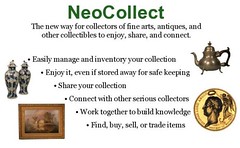 The NeoCollect website was taken down in early February, after six years of operation.
The website was originally conceived in 2008 as a way for collectors of all fine arts, antiques and other valuable collectibles – including
but not limited to numismatic items -- to manage and share their collections, and to connect with other collectors. It took the basic
concepts behind museum management software, streamlined it for collectors of just about anything, and added some functionality that one
might describe as “Facebook for your collection”. While hundreds of collectors signed up and tried it, and a small but loyal user base
became quite attached, the economics of operating the site became unsustainable. The Internet landscape – particularly with the transition
to mobile devices -- evolved too rapidly for NeoCollect to continue operating as a viable independent entity.
The NeoCollect website was taken down in early February, after six years of operation.
The website was originally conceived in 2008 as a way for collectors of all fine arts, antiques and other valuable collectibles – including
but not limited to numismatic items -- to manage and share their collections, and to connect with other collectors. It took the basic
concepts behind museum management software, streamlined it for collectors of just about anything, and added some functionality that one
might describe as “Facebook for your collection”. While hundreds of collectors signed up and tried it, and a small but loyal user base
became quite attached, the economics of operating the site became unsustainable. The Internet landscape – particularly with the transition
to mobile devices -- evolved too rapidly for NeoCollect to continue operating as a viable independent entity.
Last October, we wrote to the users to let them know that NeoCollect would no longer be available for use after the end of 2014. During the fall, we explored the possibility of combining NeoCollect into the American Numismatic Association’s “My Collections” website feature. Unfortunately, these discussions did not pan out. There were structural and code (computer language) differences that would have cost the ANA a lot of money to overcome. Also, they felt that the ANA website already had some of what NeoCollect offered (e.g., friends, messaging). We even explored enabling NeoCollect users to simply migrate their NeoCollect collections to ANA’s My Collections database in a partial fashion, but that did not work out either.
In late-December we followed up, advising the NeoCollect users that operation would be extended to mid-January, and then further extended operations to February 1. We had provided users with instructions on how to download all of their text data into an Excel spreadsheet, and some also found ways to download their photos. We also referred users to a few of the available collection management software packages, such as:
• Collector Systems (http://www.collectorsystems.com/) – a cloud-based collection management program available for $45 or $85 per month to individual collectors depending on the product selected.
• Past Perfect Museum Software (http://wwww.museumsoftware.com/) – the world’s leading software program for collection and contact management, used by many small museums and historical societies, available for $870 (or $1,245 including the Multimedia upgrade that allows you to include images).
• ArtVault Software (https://www.artvaultsoftware.com/) – another desktop collection management program available for 1,690 Swiss Francs (about $1,710).
While we didn’t endorse any of these programs, they at least represented potential collection management alternatives worth exploring.
The NeoCollect code and all of the collection data and photos were saved, should a comparable site someday emerge and Neocollect’s users decide to upload their data. At this point, the existing sites with collection management functionality follow one of two basic approaches. Some, like the PCGS Registry and HobbyDB establish a finite, specifically enumerated list of collectible items and you essentially check off what you have, in what condition. So for those with data-and-mintmark coins, these sites have the complete list and you just check the appropriate boxes. Others, like the ANA’s My Collection and the newly announced Heritage MyCollection site (which I believe were conceptualized by the same individual) are more open-ended, but extremely rudimentary and not yet easily usable.
As I say about many things in life, it’s easy to see what going to happen in the future, but very difficult to say when it will happen. I do believe that something like NeoCollect will eventually emerge again and ultimately become the standard for all sorts of collectors to manage and share their collections – I just can’t say when!
To read the earlier E-Sylum articles, see:
NEW WEB SITE: NEOCOLLECT.COM (www.coinbooks.org/esylum_v12n08a04.html)
USER REVIEW: NEOCOLLECT.COM (www.coinbooks.org/esylum_v12n14a16.html)
NEOCOLLECT.COM INCORPORATES E-SYLUM FEEDBACK
(www.coinbooks.org/esylum_v12n15a16.html)
LAUBENHEIMER FAMILY ARCHIVES IN JUNE 25, 2015 SALE
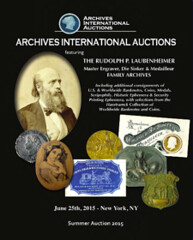 “The appearance on the market of the family archive of German-born master engraver and die sinker,
Rudolph Philipp Laubenheimer (1833-1905), is an event with few precedents in American collecting history,” stated David T. Alexander, noted
numismatist and numismatic scholar. “Preserved with remarkable care and fidelity for more than a century after the artist’s death by
generations of his descendants, this archive which spans almost six decades reveals Laubenheimer in all aspects of his art, both in print
and metallic forms.”
“The appearance on the market of the family archive of German-born master engraver and die sinker,
Rudolph Philipp Laubenheimer (1833-1905), is an event with few precedents in American collecting history,” stated David T. Alexander, noted
numismatist and numismatic scholar. “Preserved with remarkable care and fidelity for more than a century after the artist’s death by
generations of his descendants, this archive which spans almost six decades reveals Laubenheimer in all aspects of his art, both in print
and metallic forms.”
Archives International Auctions is privileged to offer the Laubenheimer Family Archives in a public auction scheduled for Thursday, June 25th, in New York City at the Collector’s Club located at 22 E.35th Street, starting at 10:30 a.m. Eastern time. The Laubenheimer session of the auction consists of 474 lots followed by 672 lots of historic ephemera, security printing ephemera, U.S. &World banknotes, coins, medals and scripophily.
Laubenheimer was noted for his extensive Civil War token designs; cameo business and corner cards; U.S., Central and South American postal stationary dies and designs including the 1870 U.S. postal stationary series in which he received a commendation by the Post Office Department; medal and die production for the Centennial Exhibition held in Philadelphia in 1876 and the Columbian Exposition held in 1892 in Chicago as well as numerous other medals, tokens, advertising, jewelry and decorative designs for various events, topics and causes. He designed, engraved and created dies for coins of Colombia; coats of arms for numerous countries and entities; as well as jewelry dies and decorative objects including various badges for police and fire departments as well as belt buckles including ones for the military.
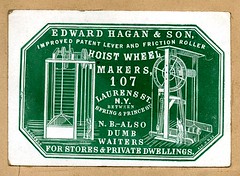 Highlights from the Laubenheimer session of 474 lots begins with an
extensive collection of 25 different Cameo Business and Corner card lots, ca.1850-60’s that include die sunk cards that were designed and
engraved by Laubenheimer and are possibly the most extensive offering of these lovely and rare items that have ever crossed the auction
block at one time. The fact that they were created by one man only adds to their desirability. Additional advertising cards for early New
York printers, some by Laubenheimer and others obtained from his contemporaries are highlighted by an early coated stock A.C. Paquet,
Business Card, ca.1850-60's who was famous for the scarce reverse design on the Liberty head $20.00 gold piece as well as many U.S.
Mint medals.
Highlights from the Laubenheimer session of 474 lots begins with an
extensive collection of 25 different Cameo Business and Corner card lots, ca.1850-60’s that include die sunk cards that were designed and
engraved by Laubenheimer and are possibly the most extensive offering of these lovely and rare items that have ever crossed the auction
block at one time. The fact that they were created by one man only adds to their desirability. Additional advertising cards for early New
York printers, some by Laubenheimer and others obtained from his contemporaries are highlighted by an early coated stock A.C. Paquet,
Business Card, ca.1850-60's who was famous for the scarce reverse design on the Liberty head $20.00 gold piece as well as many U.S.
Mint medals.
An extensive group of Die Sunk and engraved Corporate and organizational seals by Laubenheimer follow which include a diverse group of topics including military, religious, fraternal, banking, railroad and many other companies, countries, cities and states. All are proof impressions kept as a record by Laubenheimer, sometimes on his embossed letterhead. An extensive offering of “Works on Paper” including pencil and charcoal sketches, water colors and various other formats are offered and date between 1849 to 1905 including portraits, landscapes, portrait character studies and numerous artists renderings and designs for jewelry, decorative objects and medals that round out this portion of the archives.
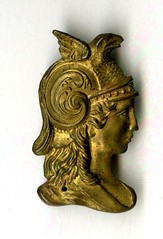 An extensive group of token, medal and jewelry design and production
material are included that is sure to attract considerable interest. The Laubenheimer section finishes with over 70 lots of Ernst
Laubenheimer, Rudolph’s son’s, commercial art and design work including work done while employed with American Bank Note Company
lithography department for many years.
An extensive group of token, medal and jewelry design and production
material are included that is sure to attract considerable interest. The Laubenheimer section finishes with over 70 lots of Ernst
Laubenheimer, Rudolph’s son’s, commercial art and design work including work done while employed with American Bank Note Company
lithography department for many years.
“We are privileged to offer this historic collection maintained by the artist’s family for over 110 years. Rudolph was truly a Renaissance man, a master of numerous art forms including engraving, die sinking, medal, jewelry and token design as well as being an avid cello player and exceptional composer”, said Dr. Robert Schwartz, President of Archives International Auctions of this, the firm’s 26th sale. “We anticipate extensive interest in the Rudolph P. Laubenheimer family archives and with this sale, are granted a view of an earlier world where artisanship and craftsmanship were treated as an art form and not a commodity”.
Also included in the sale from a different consignor is a remarkable archive from a Continental Bank Note Company engraver that was held by the family for over 130 years. Included are engravings, designs, proofs, specimens and sample books from Continental BNC and other early printers. Additional historic ephemera include Clipper Ship Trade cards, ca.1850’s as well as historic ephemera.
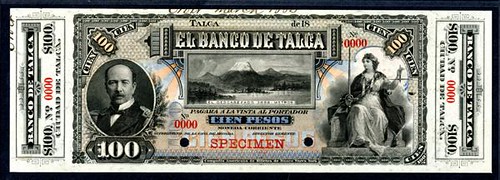
Rare proprietary proof sheets from the ABN archives are offered in the U.S. section. World banknotes follow with highlights including 3 different Angola 1944-46 Specimen banknotes; a 1966-67 Commonwealth of Australia $5 Specimen rarity; Three different lovely and high denomination Chilean Specimen notes including a 100 Pesos, Banco de Credito Unido note; A Banque de France, 1959, 500 NF Specimen in CU condition; an extremely rare and attractive Kingdom of Hawaii (ca.1879) $100 Silver Certificate of Deposit Proof that is rarely seen and is PMG graded CU 64; an extremely desirable Banque De Madagascar 1930 Issue 50 Francs Specimen in CU condition; Three exceptional Peru, El Banco Nacional Del Peru multicolor Specimens are offered that are rarely seen in any form or condition; Peru offerings also includes five different Essay Mockup Proofs of either proposed and never issued designs or designs that were close to the final design but issued slightly differently from the ABN Archives; Spain includes a very attractive and rare set of six different 1936 Banco De Espana Specimens from 10 Pesetas to 1000 Pesetas; a very attractive United Kingdom Treasury Note, 1914 ND, 1 Pound note in Choice VF condition and literally dozens of other notes that are rarely seen at auction.
U.S. Coins are represented by a wide variety of issues in various conditions beginning with a lovely New Jersey 1787 Copper penny and include early U.S. type coins, silver dollars and various issues and multiple coin lots. 6 different lots of unsearched poker chips from numerous casinos are followed by a variety of U.S. and related medals.

Colombian coins Trial Splash Designs ca.1887 by R.Laubenheimer
World coins include numerous single as well as group lots highlighted by a number of Australia, King George 5, EF to Uncirculated Shillings and Florins ca. 1917 to 1935; a Bolivia, 1686P VR, Carlos II Cob 8 Reales; an attractive assortment of German States coins, mostly in AU to CU condition with highlights including a Saxe-Weimar-Eisenach, 1908A, 5 Mark in CU 64 and a Hesse-Darmstadt, 1876H, 5 Mark NGC graded XF-40 followed by a wide variety of issuers and countries. Medals are represented by a large French medal collection with many desirable pieces.
To learn more about Archives International Auctions and the firm’s upcoming auction on June 25th, please visit www.ArchivesInternational.com. Updates are posted frequently.
SARAH SOPHIA BANKS AND THE ‘CONTINENTAL DOLLAR' OF 1776
George Kolbe writes:
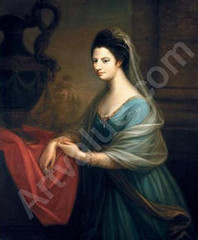 Last week I received my 2014 volume of The Numismatic Chronicle, published by the Royal
Numismatic Society. Included is a fascinating article entitled “Collecting America: Sarah Sophia Banks and the ‘Continental Dollar'
of 1776,” written by Catherine Eagleton, Curator of paper money and modern coins at the British Museum. Numismatists interested in the
early issues of our country will find it most interesting and informative — a “must read” for both those familiar with Sarah Sophia Banks
and those not.
Last week I received my 2014 volume of The Numismatic Chronicle, published by the Royal
Numismatic Society. Included is a fascinating article entitled “Collecting America: Sarah Sophia Banks and the ‘Continental Dollar'
of 1776,” written by Catherine Eagleton, Curator of paper money and modern coins at the British Museum. Numismatists interested in the
early issues of our country will find it most interesting and informative — a “must read” for both those familiar with Sarah Sophia Banks
and those not.
A Few Notes on Catherine Eagleton’s Numismatic Chronicle Article on the Continental Dollar
by David F. Fanning
The 2014 volume of the Numismatic Chronicle includes Catherine Eagleton’s article, “Collecting America: Sarah Sophia Banks and the ‘Continental Dollar’ of 1776.” This is a highly interesting article that brings to light a wonderful printed advertisement seeming to offer examples of the 1776-‐dated Continental dollar to a European public and further discusses the impressive collecting efforts of Sarah Sophia Banks. However, while both Banks and the printed advertisement are well worth writing about, Eagleton introduces a few errors into her analysis that lead her to some faulty conclusions.
Eagleton’s boldest claim in her article is the suggestion that the Continental dollars were struck in Europe and intended as medals.[1] It is clear from a handwritten catalogue entry made by Jonas Dryander and later copied by Banks that Dryander was of the opinion that the pieces were “never current, struck on speculation in Europe, for sale in America.” Nowhere, however, does Dryander give any indication of why he thought this to be the case, and there is no real reason for us to accept this opinion as evidence of anything more than the existence of an opinion.
It is the printed advertisement that is the most fascinating artifact discussed in Eagleton’s article, but her analysis is faulty in a few ways. First, she assumes a connection between the manufacturer of the piece and the person behind the advertisement, despite no such connection being claimed in the ad itself. Second, she clings to the ad’s use of the term “medal” (rather than “coin”) to describe the piece while ignoring the fact that the words were used differently at the time. (For example, John Pinkerton’s ubiquitous Essay on Medals, the main English collector’s guide of the period, is almost entirely about coins.)
More serious objections to Eagleton’s argument arise from two factual errors. First, she mistakenly states that the paper money design on which the Continental dollar dies were based is signed by E.G. (generally taken to be Elisha Gallaudet):
“if this was meant to be a medal ‘representing’ the paper money, the presence on the Continental dollar of Gallaudet’s design and initials might not indicate any direct connection between him and the cutting of its dies. ... It might equally be a case of the die-‐sinker copying the design from the paper money faithfully in all details, including its errors, and also reproducing the signature of the engraver responsible for the printing plates from which the paper money had been made.” (page 298)
In fact, only the metallic dollar is so signed: the paper money is not. This is a fairly serious lapse.
A second serious lapse comes in Eagleton’s analysis of the printed advertisement. She clearly writes on page 298 that “the advertisement states that they were minted in Europe.” It does no such thing. There is absolutely nothing said in the advertisement about where the pieces were made. Indeed, the ad describes them as “American Medals,” which if anything implies that they were manufactured in America. The only source stating that the Continental dollars were struck in Europe is Banks (who was quoting Dryander), and this is evidence of nothing other than what they thought to be the case.
There are other quibbles one might have with the article, some of them based on the revelations contained in the July 2014 article by Eric P. Newman and Maureen Levine,[2] which found that the dollars had been illustrated as early as 1783 and alluded to in print as early as 1779. But Eagleton’s errors regarding the E.G. signature and the printed advertisement are enough to call into question her conclusions. Indeed, “this example provides a caution against inferring too much from limited sources.” [3]
Notes
1. I am referring throughout to the piece as the “Continental dollar” while recognizing that this is simply the generally accepted term and not necessarily its true status.
2. Newman, Eric P., and Maureen Levine. “18th-‐Century Writings on the Continental Currency Dollar Coin,” The Numismatist, Vol. 127, No. 7 (July 2014), pp. 34–57. Given the lengthy lead-‐time of the Numismatic Chronicle’s production, I acknowledge the probability that Eagleton had not seen the Newman &Levine article prior to submitting her article.
3. Eagleton, page 300.
To read the complete article, see:
www.numislit.com/pdfs/Continental%20Dollar.pdf
To read the earlier E-Sylum articles on Sarah Sophia Banks, see:
SARAH SOPHIA BANKS (1744-1818) (www.coinbooks.org/esylum_v14n11a07.html)
MORE ON SARAH SOPHIA BANKS (www.coinbooks.org/esylum_v14n12a09.html)
SUBSCRIBER PROFILE: DON AND LOIS BAILEY
Born and reared in south-central Michigan, Don Bailey joined the Marine Corps during the Korean War. When he retired from the Marines, he lived in Yuma, Arizona, where he was introduced to the vastly interesting history of Mexico. He started collecting U.S. coins in the early 1960s, but soon turned exclusively to Mexican numismatics, concentrating at first on the coinage of Maximilian and the French Intervention. Since 1979 he has been very active in the Mexican numismatic field as a full-time dealer, attending most of the major coin shows in the United States and Mexico. His wife, Lois, has been his full-time business and research partner.
In 1967, Don started the Maximilian Numismatic and Historical Society. He published his first article, on the subject of Mexican numismatics, that same year. Since then he has written on other subjects (including the story of the 1980s forger and murderer Mark Hoffman), but Mexican history and numismatics have always been his focus. He has written articles and columns for World Coin News, Coin World, and other publications, and served as Coin World’s “Mexican Trends” analyst. He has also been a contributor to major references on Mexican numismatics, including the Standard Catalog of Mexican Coins, Standard Catalog of World Coins, and Tokens of Latin America; Frank W. Grove’s numerous volumes on medals, decorations, and tokens of Mexico; and the Guide Book of Mexican Coins, by T.V. Buttrey and Clyde Hubbard, to name a few.
Don has been a member of, and an officer in, many numismatic organizations. He is a life member of the American Numismatic Association and has been a member of the Sociedad Numismatica de México for more than 40 years, serving for a number of those years as the society’s official representative in the United States. He has worked with the Banco de México and the Casa de Moneda de México to promote their products and numismatic materials, and in 1974 he was appointed to the U.S. Assay Commission. Don has been the recipient of the ANA’s Presidential Award, the Sociedad Numismatica’s José Tamborrel Jr. Award (twice), and the Sociedad’s Alberto Francisco Pradeau Award. Numismatic News named him a Numismatic Ambassador in 1980. On September 27, 2001, Don received the Orden Mexicana del Águila Azteca (Mexican Order of the Aztec Eagle), the highest honor bestowed on a foreigner by the government of Mexico.
In June of 1997, Don, Joe Flores, and Sal Falcone organized the United States Mexican Numismatic Association, and Don served for many years as its executive director and the editor of its quarterly publication, the Mexican Numismatic Journal. The Sociedad Numismatica honored the association with the Dr. Alberto Francisco Pradeau award for promoting Mexican numismatics.
According to Don, “These fifty years have been a ball. Fifty years of working, if one can use that term, in a field that you really enjoy is all that you can ask. My wife, Lois, is a vital part of the operation. Without her assistance and encouragement the goals we have achieved would have been impossible to reach.”
AUTHOR REBUTS MISPLACED NATIVIST CRITICISM
Allan Schein of Salt Lake City, Utah writes:
Attached is a Letter to the Editor that I believe supports the philosophy of the E-Sylum, inspired by an indirect circumstance that occurred in Long Beach last week.
Coincidently, this piece I wrote several days prior to a piece by F. Michael Fazzari’s discussion of a somewhat parallel nature in the June 16 issue of Numismatic News.
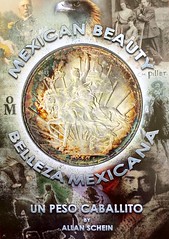 During the first week of June 2015, the Long Beach Coin Expo took place at the California Convention Center of the same name. This is
always a fun show for me and one I look forward to attending. Having recently published my book Mexican Beauty - Belleza Mexicana on
Mexico's Caballito Peso, I had several opportunities to expand my distribution with a coin supply company that exhibited there and
a major wholesale only distributor. Both companies are good at what they do and successful within their respective areas.
During the first week of June 2015, the Long Beach Coin Expo took place at the California Convention Center of the same name. This is
always a fun show for me and one I look forward to attending. Having recently published my book Mexican Beauty - Belleza Mexicana on
Mexico's Caballito Peso, I had several opportunities to expand my distribution with a coin supply company that exhibited there and
a major wholesale only distributor. Both companies are good at what they do and successful within their respective areas.
The on-site seller was kind enough to offer my book for sale, and there were a number of people that spent considerable time perusing through the pages. Unfortunately, a few waited in vain while the sellers unsuccessfully tried to locate me on the bourse floor, to whom I whole heartedly offer my apologies.
One individual however was a fellow from Mexico who told the supply company that since I was not of Mexican descent, I had no right to produce a book on a Mexican issue. It wouldn't surprise me if this was the same fellow that scolded me at the September 2014 Mexico City show. In an attempt to have a conversation, I asked if he spoke English, and was verbally reprimanded. He told me that if I want to do business in Mexico I should learn the language. Ironically, he told me this in English, then snubbed me. Nice fellow. I'm sure he works in the Public Relations department of a local corporation as some sort of friendship emissary.
Unfortunately, I was not able to connect up with this critic, because I would have explained that knowledge should not be confined within national borders, and ask what he's done lately. Other than complain that someone produced a work about a Mexican coin issue nobody, not even one of his countrymen have managed to produce to date. Hmmmmm.
The book is bi-lingual also, translated by the Mexican born numismatist, my good friend Roberto del Bosque. Even the graphic artist I worked with here in Salt Lake City, Eduardo Cuellar, is from Mexico City, and was educated there in the famed Art Institute. Now that's an International collaboration, in my assessment.
The coin's creator, French sculptor and medalist Charles Pillet designed this coin, engraved the dies and struck the proofs in Paris. In 1911 the relief was modified slightly by Pillet, and the changes engraved by Charles Barber, chief engraver of the U.S. Mint at Philadelphia. So in actuality, the things that are Mexican about the coin are the name ESTADOS UNIDOS MEXICANOS on the obverse, the silver it contains and the fact that it circulated in Mexico. Its entire creation was conceived outside Mexico and thereafter presented for production to the Casa de Moneda. Again, in reality, it's as much an international coin as it is a sovereign issue.
If books about Mexican numismatics were to be confined to those written by citizens of Mexico, or those with a connected heritage, the volumes that exist would be about half the current roster, maybe less. What if Clyde Hubbard, Dick Long, Theodore Buttrey, Don Bailey, Neil Utberg,, Hugh Guthrie, Elmer Powell, J.B. Parker, Mike Dunigan, Max Keech, Cory Frampton, Greg Meyer, Brian Stickney, Carlos Jara, Kent Ponterio and Simon Prendergast to mention a few, never wrote on Mexican Numismatics? The overall body of knowledge would be vastly diminished. Mexican authors and numismatists have produced some excellent work, but without the collaboration and contributions of the author/numismatists named above and others, the libraries of collectors on Mexican Numismatists would have many an empty bookshelf.
We're living in the 21st century. Americans are living in Mexico, and Mexicans in North America. The world has become an International community, with knowledge garnered from all corners of the planet by people from every walk of life and every nation. There are few barriers to information that is accessible to any and all interested parties, unless you live in North Korea. So numismatic treatises of every sort, on every topic by people from the Planet over have and will continue to appear as they are created.
To the individual that feels this should be restricted I can only surmise that he is either unable to produce or jealous of those who have. As a martial arts master, I find it practical, in the philosophy of Bruce Lee, to "use what is useful". Any technique that works has value, no matter the origin. The same goes for all knowledge, in my opinion. If there is a body of knowledge that can enlighten me on a subject, or increase my understanding of a coin series, I embrace it. As a student of numismatics I have learned that most everyone has something to teach, and conversely, we all have something to learn. Does it really matter where that knowledge comes from so long as it is accurate and useful? I don't think it does, but then, I try to keep an open mind because I don't know what it is I don't yet know.
Every new article, new book, new insight into a coin or piece of currency adds to the overall body of numismatic knowledge. The more that's contributed no matter the source, so long as it is viable accurate information, is of value. I encourage everyone that has learned something that they believe was previously not known or not written about to put it down on paper and submit it to The E-Sylum for publication. The more contributors, the better.
The US Mexican Numismatic Association has grown into a positive, influential, educational organization that networks hundreds of like-minded collectors, all with divergent but largely similar interests. The phrase "each one teach one" has been demonstrated over and over, and continues to expand along with that organization. The principle of shared knowledge is at the core of numismatics and no organization or publication illustrates that better than The E-Sylum.
For more information about Allan's book, see:
NEW BOOK: MEXICAN BEAUTY: MEXICO'S CABALLITO PESO
(www.coinbooks.org/esylum_v17n44a05.html)
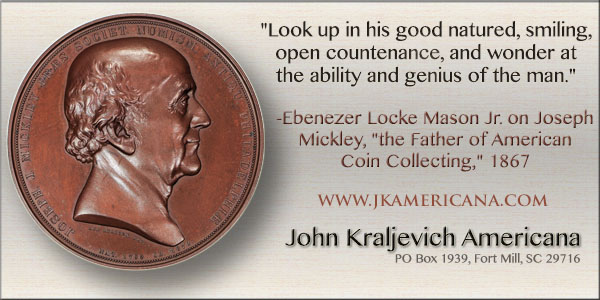
DESIGNING THE AMERICAN FIGHTER ACES MEDAL
Designing the American Fighter Aces Congressional Gold Medal
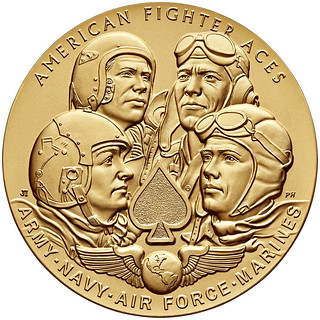 When beginning any design project for the U.S. Mint, but especially for a Congressional Gold
Medal, my very first action is to read and re-read the enacted language of the law in order to fully understand the scope and sense of what
Congress finds as the reasons for conferring its highest civilian honor on any group or individual. In the instance of the American Fighter
Aces, the Congress makes compellingly clear why this distinction and recognition is so highly deserved.
When beginning any design project for the U.S. Mint, but especially for a Congressional Gold
Medal, my very first action is to read and re-read the enacted language of the law in order to fully understand the scope and sense of what
Congress finds as the reasons for conferring its highest civilian honor on any group or individual. In the instance of the American Fighter
Aces, the Congress makes compellingly clear why this distinction and recognition is so highly deserved.
An appreciation for these particular citations which outline the history and accomplishments of the American Fighter Aces is instrumental for me to develop a sense of the range and breadth of the recipients’ contributions, which hopefully will be reflected in the artwork. Additionally, I find that my travels and experiences over the years with the U.S. Air Force Art Program have informed my designs and impart an authenticity to the artwork which pays homage to our women and men in uniform.
Although the scope and range of the Aces' service included the Spanish Civil War, Sino-Japanese War, Russian Civil War, Arab-Israeli War, and others, I focused on portraying Aces representing WWI, WWII, the Korean War and the Vietnam War. I tried to create likenesses of Aces that were representative of these distinct eras. Besides the era-specific headgear for each Ace worn in each of these conflicts, I looked at many photos of pilots from each period to come up with composites that would be believable representatives of their time and style.
For instance, the flowing and dashing white silk scarf of the young WWI Ace, the tough and seasoned craggy look on the WWII Ace, the hint of Hispanic features for the Korean War era Ace and an attempt to give a 60’s feel to the profile of the Vietnam War Ace. The military wings, which created a framework for the globe, were my attempt to symbolically say that the Fighter Aces fought for freedom and democracy around the globe in many theaters of war and truly earned their “Wings of Valor”. Lastly, I felt that the ace of spades was an important element to include, as it had a long and resonant association with the ranks of Fighter Aces from WWI to the present day.
*In the category of minutia that might be interesting to collectors and scholars, an early version of the obverse had the 5 stars emblematic of the 5 air to air victories necessary to be given the elite designation of Ace. They were removed, as the selected reverse, brilliantly designed and sculpted by Don Everhart had that element already incorporated into its design. The lower obverse inscription, “ARMY-NAVY-AIR FORCE-MARINES” replaced the original inscription “DUTY-COURAGE-AGGRESSIVENESS” which was already part of Don’s reverse design.
To read the earlier E-Sylum article, see:
CONGRESSIONAL GOLD MEDAL AWARDED TO FIGHTER ACES
(www.coinbooks.org/esylum_v18n21a10.html)
ATLAS OBSCURA LOOKS AT 1896 EDUCATIONAL SERIES NOTES
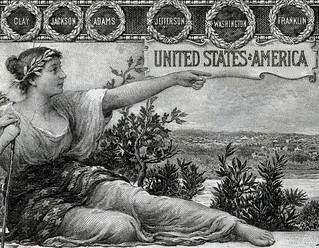 Art and money have a complicated relationship in America. But art on money has always been pretty simple: Put a dead president on
the front of a note, some numbers and a seal on the back, and cover the whole thing in a lot of squiggly lines to make it harder for people
to print their own cash.
Art and money have a complicated relationship in America. But art on money has always been pretty simple: Put a dead president on
the front of a note, some numbers and a seal on the back, and cover the whole thing in a lot of squiggly lines to make it harder for people
to print their own cash.
This hasn't always been true, though. Back in the 1890s, there was a conscious effort to turn American money into pocket-sized works of art. It resulted in the creation of what is still regarded as the most beautiful set of bank notes ever issued in the United States: the Educational Series of silver certificates.
Silver certificates, issued between 1878 and 1964, were a type of representative money that could be traded in at a bank for their face value in silver dollar coins. As with most paper currency in the United States, silver certificates usually featured a portrait of a deceased president on the obverse side of the note, which was printed with black ink. The reverse side, most often printed in green, tended not to depict any presidents or pioneers, but instead had ornate, intricate designs that swirled around the numbers and lettering to help prevent counterfeiting. In the case of the 1886 $5 silver certificate, pictured below, there was even an illustration of coins on the reverse—money depicted on your money.
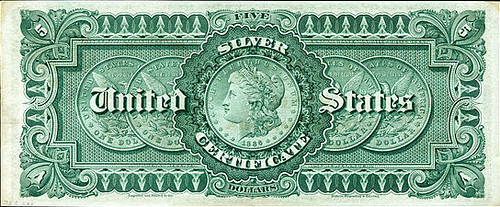
In an effort to bring more artistic merit to the silver certificate, the BEP approached Edwin Blashfield, Will H. Low, and Walter Shirlaw, three artists known for their elegant allegorical paintings. As muralists, Blashfield and Low were accustomed to working at a much larger scale than the 3.125-by-7.4218-inch dimensions of a silver certificate. But the painters' flair for eye-pleasing composition and their ability to translate principles of national character into gorgeous tableaus of women in flowing robes was paramount. They were encouraged to submit large paintings, which a team of skilled engravers could then translate to currency-compatible format. According to the aforementioned Times article, 15 to 20 engravers worked on each note, each one assigned to a particular section of the design.
The resulting three artworks formed the basis for the $1, $2, and $5 silver certificates that came to be known as the 1896 Educational Series.
The three silver certificates in the Educational Series are among 250 notes currently on display at New York's Museum of American Finance, in an exhibit titled America in Circulation. The Smithsonian's National Numismatic Collection in Washington D.C. also has a full set of the 1896 notes, while the Money Museum in Chicago has the $5—see it for yourself and decide whether it really is the most beautiful bank note ever released in the United States.
To read the complete article, see:
OBJECT OF INTRIGUE: THE MOST BEAUTIFUL BANKNOTE IN
U.S. HISTORY (www.atlasobscura.com/articles/object-of-intrigue-beautiful-us-banknote)
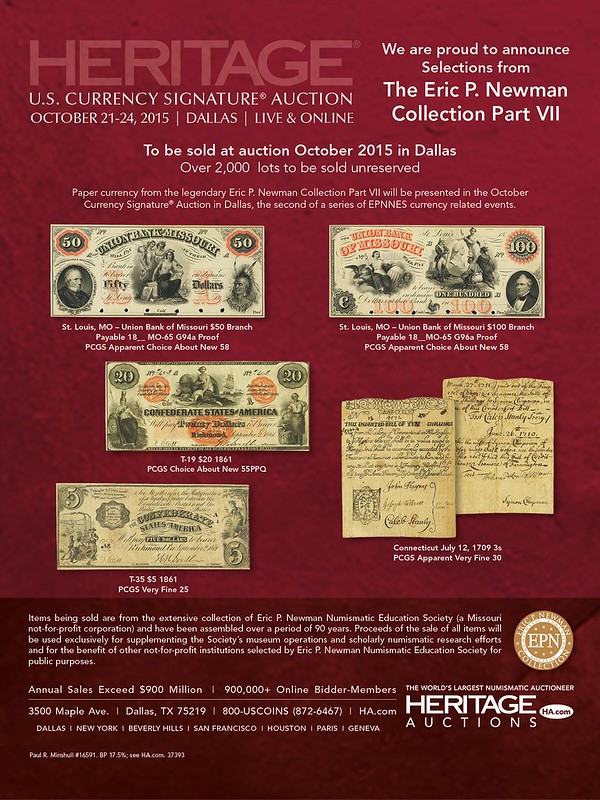
MYSTERY MEDALET ATTRIBUTED TO THE NETHERLANDS
 I have the following information about the unidentified medal:
I have the following information about the unidentified medal:
In the exergue there are the letters B.U. which stands for Begeer Utrecht. Begeer (1880-1919) were a well-known firm in the city of Utrecht in the Netherlands who made many types of medals. The medal concerned is one of their stock medals, made in different sizes and metals for awards. This particular medal is an award for homecrafts (Huisvlijt in Dutch). The reverse of the medal has space for an engraved or, in this case, a stamped inscription.
O’HOUT is an abbreviation of Oosterhout, a city located in the province of North Brabant, in the south of the Netherlands. The date is May (MEI) 1916, which is in the period of the first World War. Although the Netherlands stayed neutral during this war, the army was mobilized. Near Oosterhout there were army barracks. These were visited by the Queen on May 17, 1916. This visit is described in a newspaper for the army (Soldatenkrant, orgaan voor leger en vloot) of May 28, 1916.
The Queen also visited an “huisvlijt tentoonstelling”, an exhibition of objects made by the soldiers in their free time. This exhibition was organized by the “Comité tot ontwikkeling en ontspanning der gemobiliseerde troepen” which can be translated as Committee for development and relaxation of mobilized troops. In the inscription this was abbreviated as: C.O.O. In the newspaper article it is not stated whether or not medals were given by the Queen. My assumption is they were given by the Comité.
To read the earlier E-Sylum article, see:
QUERY: WHAT DOES THIS MEDALET'S INSCRIPTION MEAN?
(www.coinbooks.org/esylum_v18n23a27.html)
NOTES FROM E-SYLUM READERS: JUNE 14, 2015
Another Chalmers Shilling Love Token
Regarding the Chalmers shilling love token in the upcoming Numismatic Auctions sale, John Kraljevich writes:
Would you believe that's not even the only known Chalmers shilling love token?
To read the earlier E-Sylum article, see:
SELECTIONS FROM NUMISMATIC AUCTIONS SALE 57
(www.coinbooks.org/esylum_v18n23a20.html)
On the Size of the Cornell Paper Money Hoard
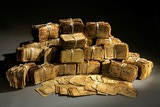 Regarding the Cornell Paper Money Hoard of North Carolina colonial notes (the remainder of which is
housed at Colonial Williamsburg), Tony Terranova writes:
Regarding the Cornell Paper Money Hoard of North Carolina colonial notes (the remainder of which is
housed at Colonial Williamsburg), Tony Terranova writes:
There were considerably more than a total of 6,700 North Carolina colonial notes in the original hoard. I personally sold about 8 or 9 thousand of them.
To read the earlier E-Sylum article, see:
COLONIAL WILLIAMSBURG'S NUMISMATIC COLLECTION
(www.coinbooks.org/esylum_v18n23a09.html)
Lost and Found Department
Dave Lange writes:
Commenting on the rediscovery of the "missing" prints at the Boston Public Library you posed the question: "Who among us hasn't misfiled something in their own library?" I'm afraid I can't be included in that list, as I recently discovered something that was quite deeply misfiled.
Like most collectors I have too much "stuff." Included among the overflow are several framed vintage coin boards holding complete or partial collections. I have too many of these to display them all at one time, so I rotate them periodically and stack the rejects vertically against the side of one bookcase. I recently went through this pile to inventory the boards, since it occurred to me that the collective value of the coins warranted recording. Within the stack I was very surprised to find my ex-wife's diploma from Pace University. I have no recollection of why it was there, and she didn't realize that it was missing. It has since been reunited with its owner.
E-Sylum reader Gosia Fort of the University of Pittsburgh Health Sciences Library System writes:
The story about misplaced items I came across is not of numismatic origin. I mentioned the rumors of missing Wells’ letters in my article for the library newsletter. I had to be very diplomatic about it, but it is very possible that these letters sat in the library’s offsite storage facility among other uncatalogued items and nobody could locate them at the time an inquiry from the author writing about “missing” items came to the library. I hope I do not have to resign because of it: it was way before my time and in addition I “found” the letters!
To read the complete article, see:
Treasures from the Rare Book Room: Horace Wells’ Letters
(http://info.hsls.pitt.edu/updatereport/?p=6746)
To read the earlier E-Sylum article, see:
MISSING PRINTS FOUND AT BOSTON PUBLIC LIBRARY
(www.coinbooks.org/esylum_v18n23a11.html)
TOKEN, MEDAL AND POLITICAL AUCTION
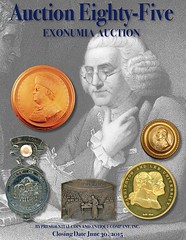
Presidential Coin & Antique Co., Inc.'s Auction Eighty-Five of Tokens, Medals and Political items closes June 30, 2015. Hardcopies $6 - contact Joe Levine at Jlevine968@aol.com or view the catalog online here .
Hard Times Tokens, 19th Century Storecard Tokens, Civil War Tokens, Military & Related, So-Called Dollars, Presidential & Political, World's Fairs & Expositions, U.S. Mint Medals, ANS Medals, Foreign Tokens and Medals, and MORE!
MORE ON THE KALAUPAPA LEPER COLONY
Ray Czahor writes:
I have visited Kalaupapa Leper Colony in Hawaii. I am not aware of any tokens/coins issued for the leper colony there although there two types of ration tickets are known to be used in the stores there. Also there are a large number of medals issued commemorating the significant work by Father Damien at Kalaupapa in treating leprosy. The key work in this area is “The Numismatic Aspects of Leprosy/Money , Medals, and Miscellanea” by Roger R. Mcfadden, John Grost, and Dennis F. Marr published in 1993. It is hardcover, 167 pages with many photos. It is out of print but I have several new copies in stock.
Coauthor John Grost writes:
In researching the book "Numismatic Aspects of Leprosy: Money, Medals and Miscellanea " we could find no reference to tokens being used in Molokai. We did find a gasoline rationing chit, a special ration ticket store receipt, and a ration bill. see pages 32 -33.
Roger Urce writes:
To answer the question as to whether tokens were used in Hawaii at the Kalaupapa Leper Colony on the island of Molokai is no according to The Numismatic Aspects of Leprosy - Money, Medals, and Miscellanea by Roger R. McFadden, John Grost and Dennis F. Marr.
According to the book, there were, however, two paper instruments reported to have been used. One is a Special Ration Ticket used as a type of letter of credit which could be spent by the person named thereon, and addressed "To the Manager Molokai Store" at the "Leper Settlement, Molokai' which was printed on the instrument. The ticket, described as being printed on light pink paper, was valued at $1.50.
The second reported instrument is a Ration Bill which directed to the Molokai store manger. According to the text the bill "allowed the patient to have ________dollars worth of goods or merchandise from the store." The store manger was to return the bill to the Superintendent of the settlement once it was spent. There also bore a maturity date, after which it became void. This bill was printed on light blue paper, and like the special ration ticket, was serialized.
Living conditions at the colony were "deplorable", and as reported, Father Damien, the patron saint of lepers, ministered to the patients between 1873 and his death from leprosy in 1889.
The book, published by D.C. McDonald Associates, Inc (1993), is available on the Internet and contains a quite a lot of information on leper colony issues.
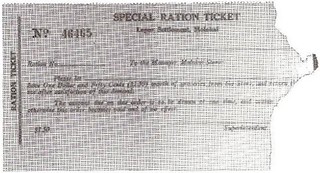
Special Ration Ticket Light Pink
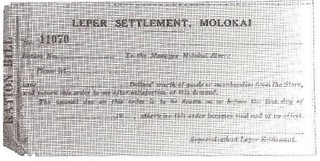
Special Ration Ticket Light Blue
Ken Spindler adds:
I used to have a rather extensive collection of token coinage of leper colonies, albeit it nothing from Hawaii. I exhibited my tokens in a few Southern California venues in 2006. My collection included multiple rarities and one K-M plate coin.
Around the time of my exhibit I tracked down Dr. McFadden and corresponded with him briefly about the hoard of Brazilian tokens which hit the market back then. Dr. McFadden's collection of Philippine Exonumia was just auctioned off by Heritage in December 2014.
In my 2006 exhibit I tried to connect to readers by pointing out: A leper colony in a tropical rainforest on a remote Amazon River island was featured in the 2004 release Motorcycle Diaries, about the medical school years of South American revolutionary Ernesto “Che” Guevara. The movie showed many real Hansen’s disease patients. You may also recall the character of the leprous king of Jerusalem, Baldwin IV, who was unmasked at death, in the 2005 film Kingdom of Heaven.
To view the McFadden Collection, see:
The Dr. Roger R. McFadden
Collection of Philippine Exonumia World and Ancient Coin Auction #241449
(http://coins.ha.com/c/auction-home.zx?saleNo=241449&ic3=ViewItem-Auction-Archive-AuctionName-081514)
Ken Berger writes:
According to "The Numismatic Aspects of Leprosy" by McFadden, Grost & Marr, a Special Ration Ticket and a Special Ration Bill were issued for the Molokai Leper Colony. However, a 1919 letter from the superintendent of the Palo Seco Leper Colony in the Panama Canal Zone refers to a local currency used at the leper colony in Molokai. Perhaps he was referring to Special Ration Ticket/Bill mentioned above.
Eventually, the U.S. did issue special tokens for the Palo Seco Leper Colony in the Panama Canal Zone. They were in the following denominations: one cent, five cents, ten cents, twenty-five cents, fifty cents & one dollar. All the tokens were the approximate size & thickness of the corresponding U.S. coins. The one & five cent coins were made of brass with a square hole, while the others were made of aluminum with a round hole. They were withdrawn from circulation in 1952 & destroyed by melting & dumping in the sea. It is estimated that only 4-5 complete sets exist. The late Harvey Rose of El Cajon had one of those sets &, I believe, Dr. McFadden also had a set at one time.
Patrick Ian Perez writes:
I read with interest the story you posted about the leper colony on Molokai. In 2008 I had the good fortune to visit the colony. At the time I was working at my Catholic parish in southern California which was staffed by priests of the Congregation of the Sacred Hearts, a religious order from which many of the original missionaries to Hawaii came from, including St. Damien of Molokai (most of which were Belgian). It was very special, because, as mentioned in the article you linked, the only way to be permitted into Kalaupapa is to be invited, and we were going as guests of the Order.
The trip was very unique; we flew from Honolulu on a small plane to the airport on Molokai. From there, my friend and I got into a four seater, and it was just the two of us and the pilot (I got the front seat!). We took off, swung out along the coast of the island, and a few minutes later landed at the very small airstrip at Kalaupapa. We were greeted by a very old Belgian Father, filled out a fair amount of paperwork, and spent the rest of the day exploring the site.
It was surreal and amazing, as aside from the three of us, there were only a few other workers scattered about, mostly at the post office they have there. Nothing but silence, the ocean, nature, and the buildings. Aside from the spiritual aspects, I did get to visit the small museum they have there with many letters, postcards and photographs, etc. I was specifically on the lookout for any type of banknotes, scrip, coins, tokens, etc. but there was none, except for (I think) an 1883 Hawaiian Quarter. The priest told me that the museum did house the Royal Order of King Kalakaua given to St. Damien (in 1881), but sadly it was stolen long ago.
I kept thinking how many amazing items must be kept there, and how I wished I could catalog and organize them. The day ended as quickly as it started, and I was back in Honolulu shortly after sunset.
To finally get around to your inquiry, I would say with near certainty that Kalaupapa did not have its own tokens or other circulating medium.
Philippine Leper Colony Tokens and Scrip
Ray Czahor writes:
The example “tokens” you mentioned are actually coins and except for the 1/2 Centavo, circulated heavily in the Philippines, not Hawaii. All denominations 1 Centavo through Peso were minted and circulated from the mid-teens through the 1930s. Also during WWII, seven denominations of emergency paper money was printed and issued in 1942.
Patrick Ian Perez adds:
I also attached a scan of a Philippines Culion Leper Colony 20 Centavo note from my collection since you posted some of the tokens.
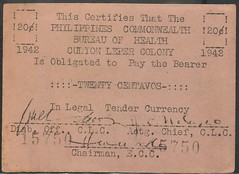
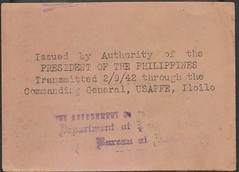
To read the earlier E-Sylum article, see:
QUERY: WERE TOKENS USED IN THE KALAUPAPA LEPER COLONY?
(www.coinbooks.org/esylum_v18n23a23.html)
OREGON TRAIL HALF DOLLAR: OBVERSE AND REVERSE
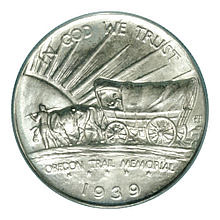
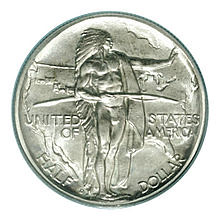
Oregon Trail Half Dollar: Obverse and Reverse
Apropos David Lange's comment on the obverse and reverse of the Oregon Trail half dollar, I went down to the ANA Library to check contemporary reports on the issue.
The Nov., 1926 issue of "The Numismatist," pp. 614-615, illustrates the coin with the wagon as the obverse. The story includes the lines "The obverse has an old-time Conestoga wagon drawn by oxen towards the setting sun." and "The reverse has a full-length figure of an Indian....The left hand of the Indian is upraised as if warning the people of the East of the perils and hardships of the Trail..."
The 1927 U.S. Mint Report illustrates the coin with the wagon as the obverse. The description includes the lines "The obverse of the coin bears a likeness of an old-time Conestoga wagon drawn by oxen over the brow of a hill and towards the setting sun." and "On the reverse of the coin appears the full-length figure of an Indian...The left hand of the Indian is raised as in in warning to those of the East."
Sounds as though they were both working from the same press release, but they do both agree that the wagon is the obverse. The U.S. Mint was certainly in a position to know.
I strongly suspect that what happened is that at some point some wag decided it would be cute to put the Indian with his upraised hand on the left side of the wagon with his upraised hand saying "STOP!" to the white man. Others copied it, assuming that the image on the left must be the obverse, and now everybody gets it wrong.


Halt!
To read the earlier E-Sylum article, see:
MORE ON OBVERSES AND REVERSES (www.coinbooks.org/esylum_v18n23a18.html)
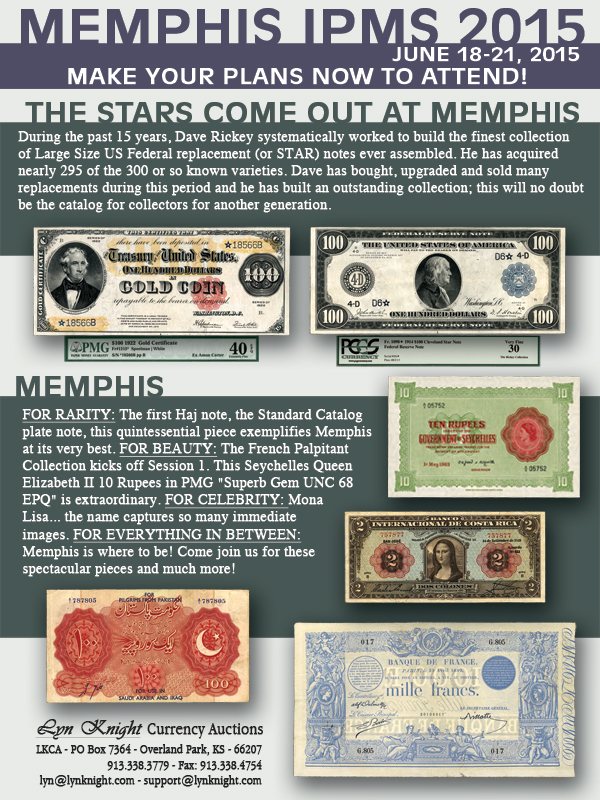
MORE RESEARCH ON THE EVERMAN COUNTERSTAMP
Bill Groom writes:
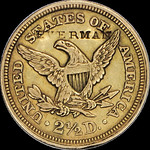 I noticed that there's some question as to who may have issued the EVERMAN counterstamp.
Whenever I'm trying to attribute a counterstamp, Philadelphia, Boston and New York City tend to be the first places I explore. In the
case of Everman, I didn't go beyond Philadelphia to find a likely suspect.
I noticed that there's some question as to who may have issued the EVERMAN counterstamp.
Whenever I'm trying to attribute a counterstamp, Philadelphia, Boston and New York City tend to be the first places I explore. In the
case of Everman, I didn't go beyond Philadelphia to find a likely suspect.
I found a jeweler by the name of Charles Everman who appears in Boyd's 1859-60 Lancaster County, PA directory, page 79. Charles is listed therein as a "jeweller" (sic), "h W. Chestnut n Mulberry."
IMHO, this Charles is a very probable issuer. Charles was likely living at the West Chestnut address in 1858-59; this, when the directory listings were being physically compiled. This listing logically coincides with the 1850's era dates of the EVERMAN host coins. Then too, Philadelphia was a center of counterstamping activity, and the small letter size of the EVERMAN counterstamp is certainly well suited to the use of a jeweler's occupation. Of course, more concrete evidence is needed to support a positive attribution.
I've been corresponding with Greg Brunk, relative to counterstamp listings in his forthcoming third edition. With regard to the EVERMAN counterstamp, Greg notes that this surname was fairly common. One of the stamps exists on a $50 gold slug, so Everman could have been a Californian. Regardless, I personally favor Charles Everman as a probable issuer; especially so, given his jeweler's trade, location and the era. He fits the profile that one might expect. Everman disappears from the Philadelphia area directories after 1859-60. Might he have traveled to California? Just a thought.
One of the fun aspects of collecting counterstamps is conjecturing about their history, their purpose. I'd offer the possibility, mind you, that Everman, whoever he was, may have stamped the few known Bust Halves and gold pieces known with his mark in order to identify his cache should it be stolen. These pieces may have been stored for future use in his trade; perhaps, intended for the melting pot. I personally doubt that word-of-mouth advertising was the reason these higher denomination pieces were stamped ... My two cents on this issue.
I'll be doing a bit more searching, but meanwhile, Charles is my odds-on favorite ...
To read the complete article, see:
NEW RESEARCH ON THE EVERMAN COUNTERSTAMP
(www.coinbooks.org/esylum_v18n23a16.html)
QUERY: WHY ARE FAMOUS NAMES USED ON OBSOLETE BANKNOTES?
Banknotes aren't my thing, really, but personal connections to Plattsburgh, NY led me to accumulate several early 19th century obsolete notes from that city. As is formulaic, these Bank of Plattsburgh notes promise "to pay (name) or bearer" so many dollars, etc.
What caught my attention were the "names." They include "H. Clay," "H. Gates," and "Thos McDonough," the last apparently being Thomas Macdonough, hero of the 1814 Battle of Plattsburgh. H. Clay and H. Gates I take to be Henry Clay and Horatio Gates, the latter also having a local connection as victor at Saratoga in the Revolution. Sometimes the names are on the plate, sometimes handwritten.
Was invoking names of national figures done to promote acceptance of the notes? Is this a recognized practice among banks of the era? I first thought the Macdonough notes were part of a gift to him by public subscription (many victorious commanders were given lavish gifts, but cash?). What then of the other names? Horatio Gates was dead (1806) by the time the notes with his name were issued in in 1818 - 1824.
I also have ten dollar notes of The Manufacturers Exchange Company of Bristol CT invoking "S. Decatur" and "T. Macdonough." This Macdonough note carries an issue date of Sept. 20, 1814, just 9 days after Macdonough's victory at Plattsburgh!
To close, some details about Bank of Plattsburgh: Niles' Register of July 24, 1819 -
"The bank of the famous and favorite town of Plattsburgh, has not suspended specie payments, as reported on the authority of an Albany paper."
Then on July 31, 1819 -
"The bank of Plattsburgh has commenced a suit against the editor of the Albany Gazette, for saying that it had stopped payment."
And on Dec. 31, 1825 -
"The banks of Niagara and Plattsburgh have closed their doors. The failure of the last is attributed to the misapplication of a large sum of money by one of the directors."
I'm attaching pictures of two notes - names highlighted.
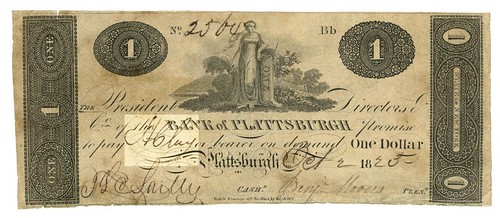
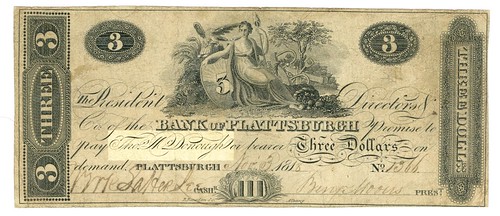
Other E-Sylum readers may have thoughts on the practice. -Editor
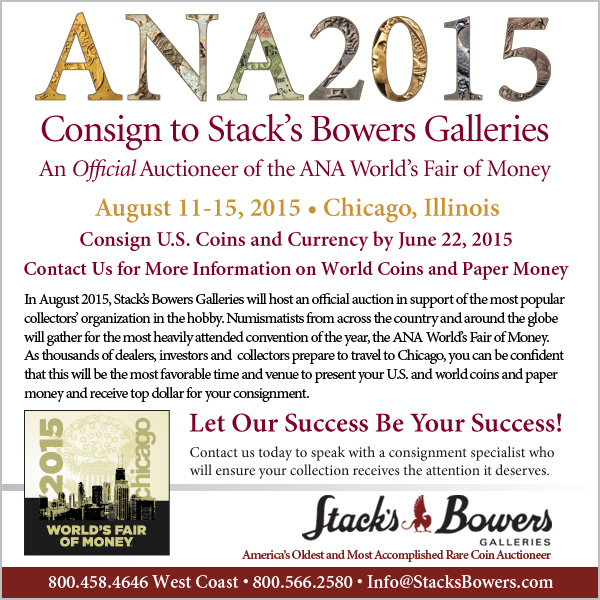
WHERE DID COPPER ORE FOR THE US MINT COME FROM?
The history of the United States cent revealed through copper isotope Fractionation
Abstract
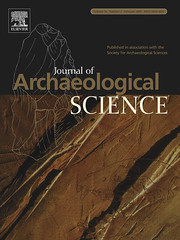 Copper isotope fractionation in United States cents traces changes in the source of copper
and identifies historical events. Application of copper isotopes as a geochemical tracer requires consistent isotopic signatures of the
ores and refined metals. Overlapping isotopic signatures of crushed ores, chalcocite and refined metal extracted from Morenci, Arizona
indicate modern mining processes that produce distinguishable single ore deposit geochemical signatures. The coincidence of copper isotope
ratios in metals and ore deposits also exists within the United States cents analyzed here. Specifically, historical records confirm two
different sources for copper in cents from 1800 through 1867. The copper isotope composition of the 1828, 1830, 1836, 1838 and 1843 cents
coincides with the Cornwall ores of England, and cents post 1850 (1859, 1862) correspond with the Michigan ores of the United States. Three
of the thirty-six post 1867 cents measured possess
Copper isotope fractionation in United States cents traces changes in the source of copper
and identifies historical events. Application of copper isotopes as a geochemical tracer requires consistent isotopic signatures of the
ores and refined metals. Overlapping isotopic signatures of crushed ores, chalcocite and refined metal extracted from Morenci, Arizona
indicate modern mining processes that produce distinguishable single ore deposit geochemical signatures. The coincidence of copper isotope
ratios in metals and ore deposits also exists within the United States cents analyzed here. Specifically, historical records confirm two
different sources for copper in cents from 1800 through 1867. The copper isotope composition of the 1828, 1830, 1836, 1838 and 1843 cents
coincides with the Cornwall ores of England, and cents post 1850 (1859, 1862) correspond with the Michigan ores of the United States. Three
of the thirty-six post 1867 cents measured possess
CHEVALIER'S COMMENTS ON U.S. GOLD COIN USAGE
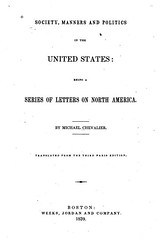 In 1834,
Michael Chevalier was sent to the US by the French Minister of the Interior to inspect our public works. Americans were building canals and
railroads like crazy at the time and Europeans were interested in our engineering and technology.
In 1834,
Michael Chevalier was sent to the US by the French Minister of the Interior to inspect our public works. Americans were building canals and
railroads like crazy at the time and Europeans were interested in our engineering and technology.
M. Chevalier, like his more famous countryman, Alexis de Tocqueville, seems to have had the idea: “Well, if I’m going there anyway, I might as well write a book about my experiences.” His book, “Society, Manners and Politics in the United States” takes the form of a series of letters and was sufficiently popular that it went through three editions in French and appeared in English in 1839. M. Chevalier provides lively comments and observations on the construction of railroads, the financial and banking environment, the state of politics and a number of other things.
Fortunately for numismatists, he also noticed and commented on the money situation in America.
In one of his first letters from the United States, dated January 5, 1834, he says: “Since I have been in the United States, I have not seen a piece of gold except in the mint. No sooner is it struck off, than the gold is exported to Europe and melted down.” (page 63)
I think he perfectly captures the situation that had existed since American gold coins were first produced in the early 1790s: the US coinage laws undervalued gold in terms of silver, so gold was exported to Europe to pay for imported goods and almost never seen in circulation in America.
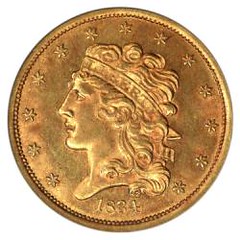 As we know, this situation was the subject of a number of arguments in Congress and wasn’t substantially
addressed until the passage of the Act of June 28, 1834, which reduced the size of US gold coins by about 6%.
As we know, this situation was the subject of a number of arguments in Congress and wasn’t substantially
addressed until the passage of the Act of June 28, 1834, which reduced the size of US gold coins by about 6%.
As suggested by the decades of political arguments, the subject of money was a potent political football: President Jackson, in particular, was opposed to banks (especially the Bank of the United States) and banknotes and in favor of circulating gold coins.
In a letter dated August 24, 1834, M. Chevalier writes:
“Gold is called Jackson money; the United States mint has been actively employed in striking gold coins, half-eagles and quarter-eagles. The principal journals of the Jackson party pay the daily wages of their journeymen printers in gold; the warm friends of the Administration affect to carry gold pieces in their pockets, and as paper [money] only is generally used here in business transactions, even of the most trifling amount, you may be certain that a man who is seen with gold in his hands, is a Jacksonman. The President lately made a visit to his seat in Tennessee, and paid his expenses all along the road in gold, and the Globe, his official organ, took care to inform the public of it. At a dinner, given in honour [sic] of him by the citizens of Nashville, he proposed this toast: “Gold and silver, the only currency recognised [sic] by the constitution!” (page 147)
For those of us who study numismatic history, we know that it’s not just about the mint facilities, or the supply of gold and silver, it’s also about politics – and pretty much always has been. M. Chevalier also provides additional confirmation that the wheels of commerce in the United States were powered by paper (currency and promissory notes) - then as now.
Fortunately for us, we need not seek out an original copy of the book or even one of the many reprints, as the book is available through the magic of Google Books.
To read the book, go to:
https://books.google.com/books?id=S0KfXK0GCBMC&
printsec=frontcover&dq=editions:gplDZ4-9DYQC&hl=en&sa=X
&ved=0CCQQ6AEwAWoVChMIsNSWgeKNxgIVC1qSCh1XjwRv
#v=onepage&q&f=false
SARAH ANN PROUT EMANCIPATION DAY TOKEN

The American Numismatic Society has dozens of identification discs, each possessing its own interesting story, but the one I want to single out was not sold to a soldier. It was inscribed with the name of a woman named Sarah Ann Prout on the occasion of the passage of the District of Columbia Emancipation Act, which was signed into law by President Abraham Lincoln on April 16, 1862. The act was a notable precursor to the Emancipation Proclamation and the debates that surrounded it. This was in a sense a model piece of legislation in that it combined emancipation with compensation to slave owners, and also provided funds to newly freed slaves willing to emigrate. The act obviously had the most direct impact on the three thousand or so slaves in the District of Columbia who were freed, but its passage was celebrated by African Americans and abolitionists around the country. The jubilation was such that Sarah Ann Prout went to a sutler and had this disc stamped to mark the day.
Who was Sarah Ann Prout? The likeliest candidate that I have been able to find is a “Sarah Prout” enumerated in the 1860 census. She was then a 33-year-old African-American woman living in Millersville, Maryland about twenty five miles east of Washington, DC. Listed as a “Free Inhabitant” of the state, her occupation was given as “Farm Laborer.” As detailed on the wonderful Legacy of Slavery in Maryland website, the slave (87,189) and free (83,942) black populations were then roughly equal in Maryland. I do not presently have access to some of the more specialized research tools and databases used by historians and genealogists so perhaps this identification is in error, but of the Sarah Prouts listed in the census she seems to make the most sense in terms of both background and geography.
Perhaps she was attracted to work in the burgeoning military camps and complexes that sprang up around Washington as the war effort expanded. The passage of the Emancipation Act would certainly have been an occasion for celebration by the black community in and around the District of Columbia. Moreover there is always the possibility that this Sarah Prout, although free in 1860, was born into slavery, which would make the day particularly redolent. While this presupposes much, the token was certainly purchased by someone for whom the Emancipation Act was a significant event, and perhaps further research will tell us more about Sarah Ann Prout’s experience.
As it was in many other African American communities around the United States, the day of emancipation subsequently became something of an annual holiday that was celebrated with a festival and parade. Indeed, it is observed in Washington DC to this day.
For more on sutlers and Civil War-era numismatics see Francis Lord, Civil War Sutlers and their Wares (1969); David E. Shenkman, Civil War Sutler Tokens and Cardboard Scrip (1983); Larry B. Maier and Joseph W. Stahl, Identification Discs of Union Soldiers in the Civil War (2008).
To read the complete article, see:
EMANCIPATION DAY TOKEN: SARAH ANN PROUT
(www.anspocketchange.org/emancipation-token-sarah-ann-prout/)
THE BOOK BAZARRE
SOME ODD TOKEN CONCOCTIONS
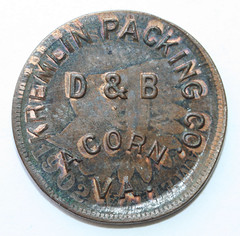
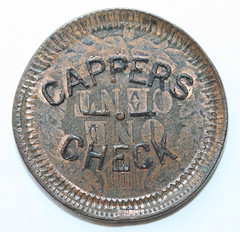
Fantasy Acorn Kremlin Packing Token
David Schenkman writes:
The token was struck on a 1902 cent using an obverse die cut for an Acorn, VA merchant and a mismatched “stock” reverse die. These dies and many others from S. H. Quint’s Sons Company of Philadelphia, were sold in the 1960s. The company’s representative ran a couple of ads in the TAMS Journal offering them for sale, and I bought quite a few from him just to get them off the market. The person who struck this also created “rarities” using other VA dies. I’m pretty sure it was a dealer who used to set up at a lot of Maryland shows, but I don’t have proof. He sold them at his table, in the $15 range as I recall. Fortunately for collectors, he didn’t have matched obverse and reverse dies. He also utilized a die cut for W. E. Jones, Limeton, VA to make tokens.
Eric Schena writes:
One of the pieces I recall was a concoction using the Jones / Limeton die over struck on a 1902 V nickel. I have also seen similar "tokens" made from a lower denomination obverse die made for W. A. Powell from Boykins. Some years ago I managed to snag one of the Powell dies, in part to get it out of circulation much like Dave did. I have sadly seen a few of these fantasies fetch what I would call absurd prices.
Here are several pictures of note. First are of the real deal - an aluminum Kremlin Packing Co. token good for one bucket. It's in rough shape as it has been dug, but this is the token as issued by the cannery.
I also collected some images of a few other examples of those modern fantasy tokens from old eBay listings. The first one is one using the obverse die intended for W. A. Powell & Co. tokens and overstruck on a cent of some kind, though the strike was strong enough to obliterate most of the undertype. The obverse die for the 50 is in my collection.
The second piece is one I saw many years ago using a W. E. Jones Limeton obverse die. It's double struck on a 1902 V nickel matched up with a "RECEIPT FOR 5 IN LABOR" die.
Another Limeton piece de caprice using the same reverse die as employed on the W. A. Powell fantasy I picture here is illustrated on Richard Greever's Token Catalog site. Modern day token chicanery!
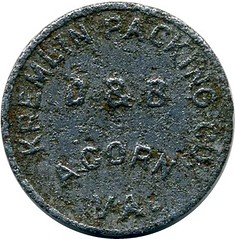
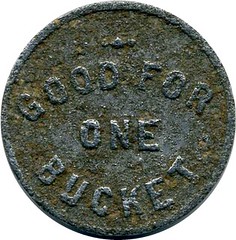
Genuine Acorn Kremlin Packing Token
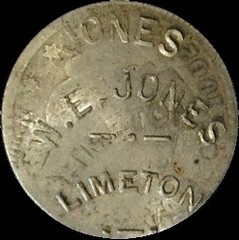
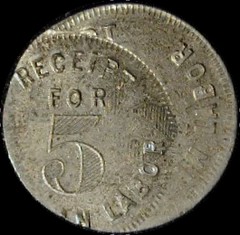
W E Jones Limeton Fantasy Token
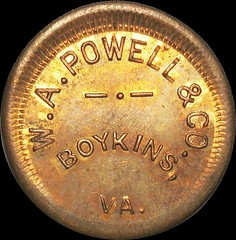
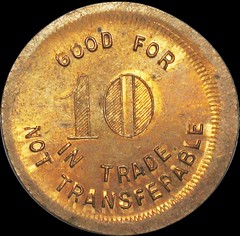
W. A. Powell Boykins Fantasy Token
To view the Token Catalog entry, see:
W.E. JONES / LIMETON / VA
(www.tokencatalog.com/token_record_forms.php?action=DisplayTokenRecord&td_id=293815)
THE JOHN WANAMAKER MEMORIAL MEDAL
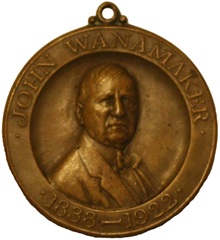
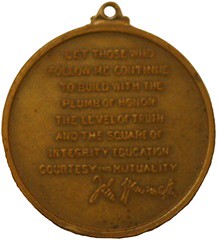
This is a 1½-inch bronze medal with an integral loop issued to commemorate the life of John Wanamaker in 1923. The sculptor is unknown and there is no maker's mark.
Obverse: John Wanamaker (1838 – 1922) was a merchant, religious leader, civic and political figure, a proponent of advertising and a pioneer in marketing. Wanamaker was born in Philadelphia, PA. Oak Hall, the men's clothing store he started with his brother-in-law grew substantially based on Wanamaker's then-revolutionary principle: "One price and goods returnable." In 1869, he opened his second store and capitalizing on his own name (due to the untimely death of his brother-in-law), and growing reputation, he renamed the company John Wanamaker & Co. In 1875 he purchased an abandoned railroad depot and converted it into a large store, called John Wanamaker & Co. "The Grand Depot."
In 1889 Wanamaker began the First Penny Savings Bank in order to encourage thrift. That same year he was appointed Postmaster General by President Benjamin Harrison. Wanamaker was credited with introducing the first commemorative stamp and making many efficiencies to the Postal Service. He was the first to make plans for rural free delivery, although the plan was not implemented until 1897 ( four years after Wanamaker left office). Wanamaker opened his first New York City store in 1896 and continued to expand his business abroad with the European Houses of Wanamaker in London and Paris.
John Wanamaker was a Pennsylvania Mason. The John Wanamaker Masonic Humanitarian Medal was created by resolution of the Grand Lodge of Pennsylvania at the December Quarterly Communication of 1993. It is awarded to a person (male or female) who, being a non-Mason, supports the ideals and philosophy of the Masonic Fraternity. The recipient of this medal is one who personifies the high ideals of John Wanamaker - a public spirited citizen, a lover of all people and devoted to doing good.
Reverse: An 8-line quote signed by John Wanamaker with his facsimile signature: LET THOSE WHO / FOLLOW ME CONTINUE / TO BUILD WITH THE / PLUMB OF HONOR / THE LEVEL OF TRUTH / AND THE SQUARE OF / INTEGRITY EDUCATION / COURTESY AND MUTUALITY.
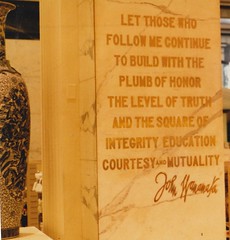 This
inscription was written by Wanamaker himself as a guide for those who took over the business following his passing. The Working Tools of
Masonry were obviously the building blocks for his instructions to future generations. Since the public would never see the capstone at the
top of the building, these guidelines were also engraved into pillars in the main lobbies of both the New York and the Philadelphia stores
with the lettering picked out in gold.
This
inscription was written by Wanamaker himself as a guide for those who took over the business following his passing. The Working Tools of
Masonry were obviously the building blocks for his instructions to future generations. Since the public would never see the capstone at the
top of the building, these guidelines were also engraved into pillars in the main lobbies of both the New York and the Philadelphia stores
with the lettering picked out in gold.
The pillar to the left is in the Grand Court of the Philadelphia store. It is nicely consistent that the layout of the quote on the pillar matches the back of the medal.
Harry adds:
I was disappointed that I could not find the name of the artist who did the bust of Wanamaker on the medal I wrote about.

Archives International Auctions, Summer Auction 2015
The Rudolph P. Laubenheimer Family Archives
Highlights include:
- Lot 30: A.C. Paquet, Business Card ca.1860-70's
- Lot 66: Exposition prize medal line art
- Lot 303: New Orleans, Cotton States Exposition, 1884 Lead Die Trial
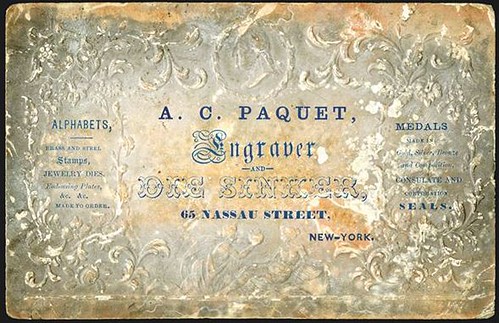
1580 Lemoine Avenue, Suite #7
Fort Lee, NJ 07024
Phone: 201-944-4800
Email: info@archivesinternational.com
WWW.ARCHIVESINTERNATIONAL.COM
WILLIAM BUTLER YEATS COIN LAUNCH CEREMONY
As tribute to William Butler Yeats, one of Ireland’s best known poets, playwrights, authors as well as a Nobel Prize winner for literature, the Central Bank of Ireland launched on the 3rd June, their latest collector coin very fittingly at the Abbey Theatre in Dublin, which was co-founded by Yeats in 1904. As the portrait of Yeats was seen in the backdrop during the presentation, guests were reminded of the great impact Yeats had on the country’s awareness on national identity and consciousness during the years leading up to an independent Irish state. William Yeats is credited with making a significant contribution to this achievement through his writings and as the country moves ever close to celebrations marking Ireland’s 100th anniversary of nationhood, the contributions of many of its noteworthy personalities are gaining in importance.
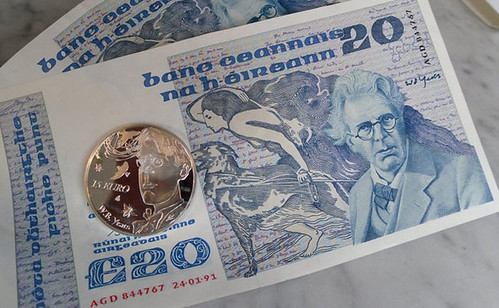
Born in 1865 in Dublin, the coin is issued in honor of Yeats’ 150th anniversary of birth and is partly released in tribute to the man whose birth anniversary will not only be celebrated in Ireland but in many countries around the world. Yeats’ plays, poems and stories were translated into many languages not just during his lifetime but almost continuously since their publication, his many works still widely admired internationally. William B. Yeats was nationally honored in 1980 when his image was included on the £20 banknote. This note remained in circulation until 1992 with the issue of the country’s third and final series. The Punt was replaced with the Euro single currency in 2002.
Invited guests were addressed by Simon Harris, Minister of State whose department oversees the issuance of Ireland’s coinage – both circulation and commemorative. Mr. Harris also spoke of Yeats’ contribution to both literature and in service to the nation during the critical early years of statehood. As Yeats was appointed a Senator for two terms in 1923, his connection and contributions to the government were substantial and still remembered.
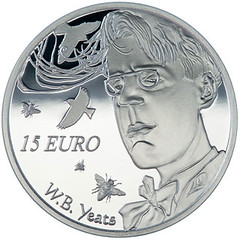 Commissioner Geraghty then proceeded with presentations of the coin during the event with the first strike being presented to Caitriona
Yeats, Granddaughter of William Yeats who accepted the coin on behalf of her family. Ms. Yeats, a concert harpist traveled from Copenhagen,
her home to receive the first strike and to represent the Yeats family. The second strike of the evening was presented to the talented
designer of the central Bank’s latest silver coin, the artist Mary Gregoriy, a COTY winner for her James Joyce collector coin who spoke of
her inspiration in the design, mentioning his “run-away” poet’s hair which is a feature of the design but also of the birds present on the
design and their symbolic meaning to Yeats during his lifetime.
Commissioner Geraghty then proceeded with presentations of the coin during the event with the first strike being presented to Caitriona
Yeats, Granddaughter of William Yeats who accepted the coin on behalf of her family. Ms. Yeats, a concert harpist traveled from Copenhagen,
her home to receive the first strike and to represent the Yeats family. The second strike of the evening was presented to the talented
designer of the central Bank’s latest silver coin, the artist Mary Gregoriy, a COTY winner for her James Joyce collector coin who spoke of
her inspiration in the design, mentioning his “run-away” poet’s hair which is a feature of the design but also of the birds present on the
design and their symbolic meaning to Yeats during his lifetime.
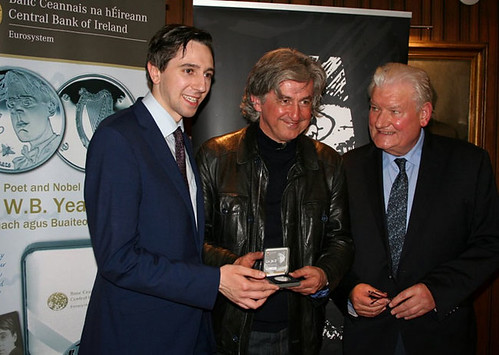
The third strike coin was presented to Fiach MacConghail, the Director of the Abbey Theatre.
The third coin was presented to the Yeats society whose activities include a scholastic program now in its 55th year as well as a comprehensive library where the works of Yeats are read and recited daily. The society is located in county Sligo, where the Yeats has a very close connection with the area.
To read the complete article, see:
William
Butler Yeats Silver Proof Coin Launched in Dublin by Central Bank of Ireland
(http://news.coinupdate.com/william-butler-yeats-silver-proof-coin-launched-in-dublin-by-central-bank-of-ireland-4869/)
ON MUTED, PICTORIAL AND MINIMALIST COIN DESIGNS.
Jeff Starck is the Senior Editor, World Coins for Coin World. He writes:
I read with interest your comment about minimalist coin designs in the June 7 edition of The E-Sylum. You see, Coin World columnist Rita Laws just wrote her Going Topical column about this very topic, calling the designs on these coins “muted”.
Muted or minimalist, either word works to describe the trend, and it is a trend. We see it more and more, driven not only by the private issuers seeking to issue designs that are more medallic in nature but by national mints.
The sheer abundance of new issues pouring forth means that there are ample examples to collect.
Here come the rebels.
The James Dean of world coins, the muted coin, is the hottest new trend in commemorative design.
Coins typically have the nation name on one side and the date and denomination on the other. These rule-breakers place all words and numbers on the obverse and edge and nothing on the reverse. The picture tells 100 percent of the story, an option once traditionally limited to art medals.
A Swiss 10-franc coin issued in 2015 weaves a tale back and forth across the surface of the coin. The reverse depicts one of Switzerland’s most important cultural traditions, “Alpabfahrt,” celebrating the return of cattle from the Alpine pastures at the end of summer.
Muted coins may have complex designs like the Swiss coin or a single centered design element.
And then there is the singular element that is repeated.
If you are of a certain age, you might remember something called the filmstrip from your school days, made up of many consecutive photographic slides spliced together.
If you took a filmstrip of a galloping horse and applied it to a coin, you’d have something like the muted $2 coin that Niue issued in 2014. Created for the Chinese Lunar Year of the Horse, the donut-shaped 2-ounce silver coin has a reverse made up entirely of a series of images showing the motion of a running horse, step by step.
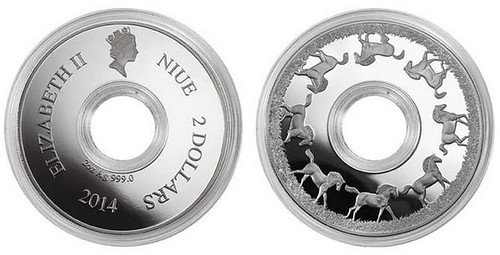
Niue Galloping Horse coin
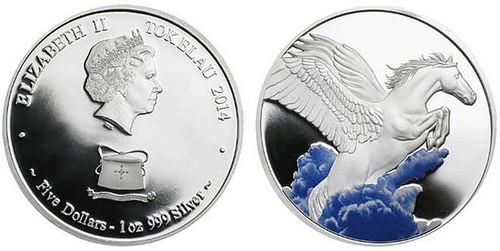
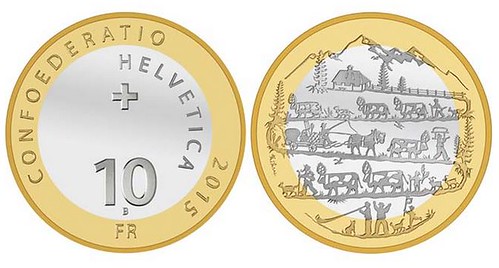
2015 Swiss Alpabfahrt coin
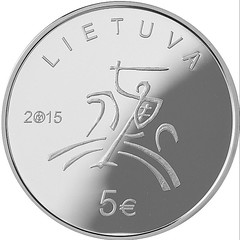
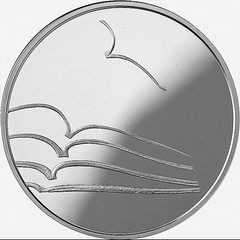
2015 Lithuania 5 Euro coin on Literature
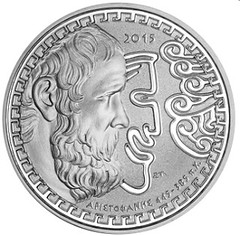
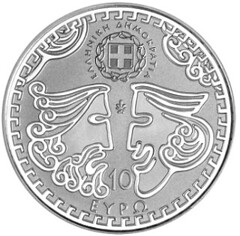
2015 Greece 10 Euro on Aristophanes
To read the complete article, see:
When pictures tell the story:
muted coins are a hot trend (www.coinworld.com/insights/when-pictures-tell-a-story--muted-coins-are-a-hot-trend.all.html)
To read the earlier E-Sylum article, see:
SOME RECENT COIN DESIGNS: JUNE 7, 2015
(www.coinbooks.org/esylum_v18n23a28.html)
FALUN GONG OVERSTAMPED NOTES CIRCULATING IN CHINA
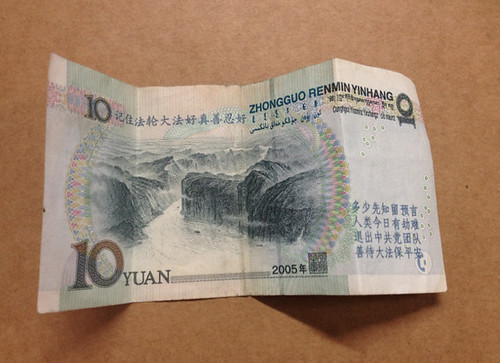
I have a very special Chinese banknote. It’s only worth ten Yuan, but it might be the most precious object I own. The front of the note shows a drawing of the former leader of the Communist Party, Mao Zedong... What’s special about my banknote is that in China—a country where everything is about money, money, and more money—nobody accepts the damn thing. It’s practically worthless. And I now understand why.
During a recent reporting trip to China, I found myself with a group of journalists and Chinese fixers sitting in the biggest mall in Shanghai... When it was time to pay for the food, we all pulled out our cash. Amy, a Chinese student who showed us around, took the stack of bills and handed it to the waitress. Not long after that she came back with one piece of legal tender in her hand, stammering that the restaurant didn’t accept the cash because it was a “bad note.” I asked why, but she wouldn’t say. “Later, later,” she told me. When she offered up the bad banknote to my group, I snatched it up.
At first sight, it was just an ordinary 10 Yuan. Mao, a small rose, and the official logo of the Communist Party were on the front, while a charming Chinese mountain scene with rivers was on the back. But if you look closer, you’ll see the stamps. Amy pointed them out to me a few days after the incident. There were Chinese characters on the bill that didn’t belong there. “This is anti-Communist Party,” she said. “The note says you have to abandon the Party in order to be free.”
In China, protesting against the Chinese Communist Party (CCP) is dangerous—especially if you disrupt the public peace. And in China this is a pretty broad concept.
After my trip in China, I traveled to the Netherlands. Although, I was finally beyond the reach of the CCP, I didn’t even know where to start in terms getting to the bottom of the banknote. So, I brought it with me to Amsterdam’s Chinatown to ask some Chinese-Dutch folks exactly what it means, hoping they’d spill the beans or point me in the right direction.
On a rainy day, after cowardly passing by ten times or so, I stepped into a Chinese acupuncturist’s office. Behind the counter, I found a man who was about 40 years old, sporting a white coat. I told him my story—that a restaurant in China wouldn’t accept my banknote and that I had no idea why. The man grabbed the note from me and analyzed its front and back. Then he glared at me and threw the bill in my face. “This is not good,” he said. “This is a bad movement against the Chinese Communist Party. This is Falun Gong. This is not good at all.” That’s the only thing he would to say about it. Before it got too awkward, I quickly thanked him and ran out of the store.
To make sure he wasn’t pulling my leg, I walked into a Chinese restaurant down the street. A middle aged Chinese man welcomed me. He took his reading glasses off and stared at the banknote for a while. Then he looked at me and said, “This? This is nothing. These are just rules. Communist Party rules. This is just what you are supposed to do in China.” He passed the bill back and started an extensive conversation about his holidays to China and the fact that he didn’t have many customers during Christmas. He clearly didn’t feel comfortable talking about Falun Gong, whoever that was.
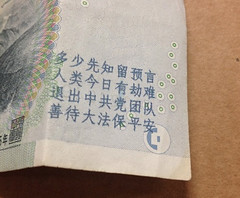 I
finally found someone willing to openly discuss my strange Chinese currency—sinologist Stefan Landsberger from Leiden University translated
the stamp on the bill in the following way:
I
finally found someone willing to openly discuss my strange Chinese currency—sinologist Stefan Landsberger from Leiden University translated
the stamp on the bill in the following way:
How many prophets have warned
Humanity knows great decay
Retreat from the ranks and levels of the Chinese Communist Party
And wait for the moment till the Great Law will guard peace
That Great Law is another name for the Fa, the theoretical arm of Falun Gong. The movement was introduced in China in 1993 as a spiritual discipline. By 1999, tens of millions of Chinese people were practicing Falun Gong. It became so immensely popular among the population that it frightened the powers that be. The Communist Party has gone to great lengths to supress the movement, even though the group's millions of followers contend that they only want recognition, not political power. Human rights groups attest that the CCP is responsible for imprisoning and executing thousands of Falun Gong practitioners. Also—according to China watchers—thousands of Falun Gong followers were sent to labor camps in order to convince them to abandon the spiritual discipline.
The note that I intercepted was printed in 2005. It has, including the stamp, been able to circulate among the people of China for a maximum of nine years, without the CCP ever finding out about it. The most recent stamped bills were printed in 2011. I wonder if still, somewhere in a secret place in China, someone is stamping banknotes with Mao, a rose, a charming Chinese mountain scenery, and a bold protest slogan.
To read the complete article, see:
I Have a Chinese Banknote That Everyone in
China Is Scared Of (www.vice.com/read/i-have-a-chinese-banknote-everyone-in-china-is-scared-od)
THE BOOK BAZARRE
BANK OF ENGLAND CHIEF CASHIER VISITS STUDENTS
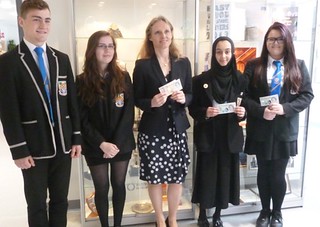 Pupils at Eastwood High enjoyed a talk by a very special guest – the chief cashier of the Bank of
England, whose signature is on all the banknotes in the country.
Pupils at Eastwood High enjoyed a talk by a very special guest – the chief cashier of the Bank of
England, whose signature is on all the banknotes in the country.
Victoria Cleland was at the school to give S3 pupils some insight into the design and manufacture of banknotes.
Ms Cleland’s signature has appeared on £10, £20 and £50 Bank of England notes since March this year.
She spoke to pupils studying graphic communication and design and manufacture.
The talk focused on the design and production processes of manufacturing banknotes, as well as the constraints and security elements of creating them.
Headteacher Stuart Maxwell said: “It was a very interesting and successful visit and it was an honour to be chosen to host the talk.”
Her visit coincided with the campaign for the public to take part in a consultation relating to who should appear on the next £20 note.
To read the complete article, see:
Design
students have something to bank on
(www.glasgowsouthandeastwoodextra.co.uk/news/local-headlines/design-students-have-something-to-bank-on-1-3792890)
WAYNE'S NUMISMATIC DIARY: JUNE 14, 2015
The June meeting of my Northern Virginia numismatic social group Nummis Nova took place a day earlier than our usual second Tuesday. It was a special event. Around 6pm Monday June 8, 2015 several of us (and several spouses) boarded the riverboat Dandy for a dinner cruise up and down the Potomac River. It was the first time we've tried such a venue, and it was enjoyable despite some occasional rainshowers.
My wife couldn't attend, so I went stag, as did Jon Radel, who organized the evening for us. Thanks! Other attendees included Dave and Joanne Schenkman, Wayne and Karin Herndon, Joe and Hope Esposito, Joe and Alice Levine, Eric and Heather Schena, Tom and Dot Kays, and Gene and Amelia Brandenburg. Everyone boarded from the dock in Old Town Alexandria, VA.
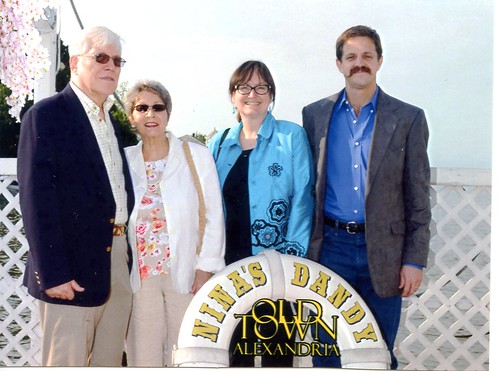
Dave and Joanne Schenkman, Karin and Wayne Herndon,
Numismatic discussion was kept to a minimum, although we did discuss an odd Acorn, VA token that's described in detail elsewhere in this issue. It was a fun evening, and we enjoyed seeing the monuments and skyline of Washington D.C.
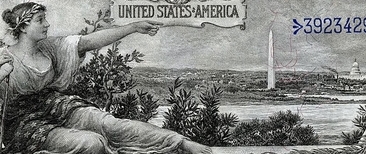
Heather Schena Pointing to Landmarks From the Top Deck
It was an expensive evening, but everyone expressed interest in trying it again sometime. As always, the best part of Nummis Nova meetings is simply the fellowship of those who share (and put up with) our common hobby. 'Til next time.

THE PARADOX OF BYZANTINE SILVER
The position of silver in the hierarchy of metals struck during the sixth century was a curious one. In the East, the currency in ordinary circulation consisted entirely of gold and copper. Though a number of silver coins of different types and modules have survived, they have usually done so only in twos or threes; several indeed are known only from unique specimens.
-- Philip Grierson, Byzantine Coins (1982)
GOLD IS SCARCE. SILVER? Not so much. We expect silver coins to be more abundant and less valuable than gold ones. In the ancient world the silver/gold ratio fluctuated within a fairly narrow band – between 10:1 and 14:1. But for the Eastern Roman Empire (which we call “Byzantine”), this assumption breaks down; paradoxically, gold is often common and silver is usually scarce, sometimes almost non-existent. For example, the vast British Museum collection database reports only 112 hits for “coin, silver, Constantinople, AD 610-1000.” The American Numismatic Society’s (ANS’s) collection of some 13,000 Byzantine coins included only 289 examples of silver for the period AD 500-1000, and many of these are tiny fractional denominations from Western mints. During the terrible third century AD (CE), the Roman economy experienced ruinous inflation and the currency was gradually debased, becoming mostly copper alloy with a trace of silver. At the beginning of the fourth century there was a recovery, with the return of a high-quality silver coin–the argenteus (issued 294-310)–at a weight of 96 to the Roman pound. Over several decades, the standard shrank to 144 to the pound, but the metal remained quite good. It was probably still called an argenteus but modern numismatists call it a silique, after a small unit of weight that was the equivalent value in gold. During the fourth century the empire lost control over silver mines in Spain, Britain, and the Balkans. The rise of Christianity as the state religion “immobilized” tons of silver in the form of altar vessels and church fittings. By the year 500, silver disappeared as part of the regular currency.
The Miliarense
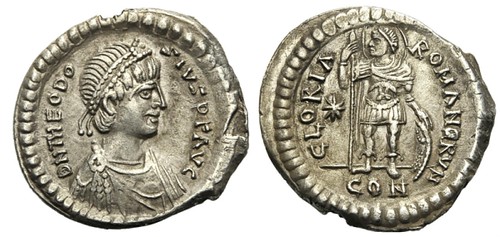
With the high-value gold solidus ... as the basis of the currency, alongside an ever-changing variety of low-value coppers, small change was a big problem. Imagine modern Americans facing a cash-only economy consisting mainly of hundred dollar bills at one end (with a few fifties and twenties,) and nickels, dimes and quarters at the other.
As part of his currency reforms, Constantine introduced a fine silver coin called the miliarense (from the Latin miliarensis (meaning “of a thousand”), because a thousand of these coins roughly equaled the value of a pound of gold, a unit used to express large sums such as the salaries of officials). There were two versions: a “light” miliarense struck at 72 to the pound, and a “heavy” 60 to the pound. One gold solidus was worth 14 heavies or 18 lights.
Miliarenses were handsome, well-made coins, and many surviving specimens are pierced for wear as ornaments or amulets[6]. A typical obverse design was the emperor’s portrait, while the reverse often showed his standing figure in military garb, striking a noble pose and surrounded by the Latin motto GLORIA ROMANORUM (“Glory of the Romans.”)
The Hexagram
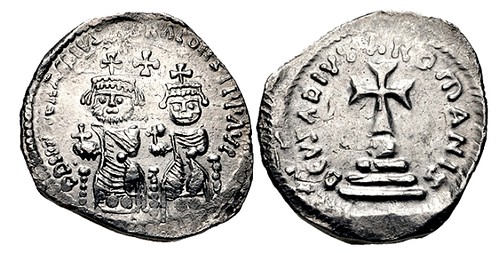
At the beginning of the seventh century, the Empire was in deep, deep trouble. When Heraclius overthrew the tyrannical Phocas (602 – 610), the frontiers were collapsing and the treasury was nearly empty. In 614 the Persians captured Jerusalem, seizing the most precious relic of the Orthodox Church: the True Cross, supposedly discovered by St. Helena, mother of Constantine the Great, in 326 CE. The Persians soon occupied Egypt, the empire’s richest province.
Short of gold to pay both his troops and imperial officials, in 615 Heraclius introduced an emergency silver coin, the hexagram. Struck at a standard of 48 to the pound (6.8 grams), and valued at 12 to the gold solidus, the coin bore the image of Heraclius and his infant son Heraclius Constantine enthroned side by side. Over the next 23 years, the son gradually gets bigger and bigger, and is eventually bearded. The reverse bore a cross over a globe above three steps, with the Latin invocation DEUS ADIUTA ROMANIS (“O God, Assist the Romans.”) A very rare half-hexagram is known from only two examples. A few hexagrams were struck at Ravenna in Italy, but the coin never caught on in the western provinces, where tiny silver coins like the “quarter siliqua” were preferred.
A new design appeared in 638 when a second son, Heraclonas, was crowned as co-emperor. Considerably more rare (only issued for three years), it shows the three rulers standing together.
Numismatic Literature
Byzantine silver is a challenge for collectors. A few common types can be found for under US$100, but scarce types in high grades may only
appear on the market once or twice a decade, and competition can be fierce, with prices in the thousands, or (recently) tens of
thousands.
The standard reference for Byzantine coinage is the massive and costly Dumbarton Oaks Catalogue (1966 – 1999, commonly abbreviated as “DOC”) in five volumes. David Sear’s Byzantine Coins and Their Values (1987) is affordable, and essential to the serious collector, but becoming outdated.
The only book about hexagrams, Yannopoulos (1978) in French, is hard to find.
To read the complete article, see:
CoinWeek Ancient Coin Series – The
Paradox of Byzantine Silver (www.coinweek.com/ancient-coins/coinweek-ancient-coin-series-paradox-byzantine-silver/)
THE SESTRORETSK AND PUGACHEV RUBLES
THE STRANGE TALE OF THE SESTRORETSK AND PUGACHEV RUBLES
The advent of eBay and other online auction sites has greatly expanded the availability of rare and unusual numismatic items. I have an interest in the copper coinage of 19th century Russia, especially the coins issued under the reigns of Peter III, limited to 1762 and Catherine II (The Great), covering 1762-96. There are numerous instances of coins being struck over coins of earlier rulers, of which I have made a particular specialty. The presence of eBay has allowed me to purchase a number of nice coins, some of them directly from Russia. I have two pieces in my collection that have been struck from the dies of the same design. One is renowned as the world’s largest round copper coin, and the other is a famous fantasy piece struck especially for collectors. Both are copper, but that is where their commonality ends.
THE SESTRORETSK RUBLE
In 1769, Catherine II instituted an issue of paper assignats to finance a war. The amount issued in 1769 – 2,169,975 rubles – grew to
3,757,700 rubles in 1770, and 4,291,325 in 1771.
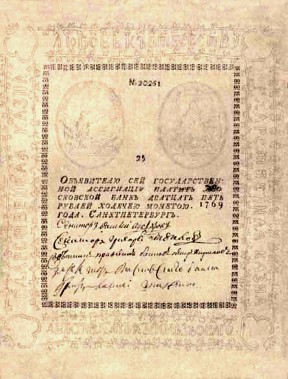
25 RUBLE ASSIGNAT ISSUED IN 1769
These were to be backed by and fully exchangeable for copper currency. Since it was surmised that not too many holders of the paper assignats would ask to exchange them for the large and heavy copper coins, and the mints could not keep up with the demand for 5 kopeck pieces, the largest copper coin minted at the time, it was proposed that a copper ruble could be more efficiently produced than twenty 5 kopeck pieces. Thus, a law was enacted in 1770 calling for the issue of copper rubles. Production was to take place at the Military Ordnance Works at Sestroretsk (sometimes spelled Cestroretsk) near St. Petersburg.
Completely new machinery was constructed to make the massive 1000 gram planchets. Because of the thickness of the required planchets, it was decided to saw them from copper rods of the appropriate diameter. That proved to be a problem: the machine had 25 saws that each had to be water-cooled. Despite the cooling water, the saws soon overheated and produced planchets of impossible forms. An alternate procedure whereby planchets were cast, then lathed to the needed specifications was tried. This proved to be too expensive. After 8 years of experimentation and frustration, the few original test samples were sent to the Senate and the dies were stored at the St. Petersburg Mint.
Two specimens date 1770 were recorded, one of which is housed in the Hermitage Museum in St. Petersburg. Showing signs of mutilation by a sharp instrument, it is 72.5 mm in diameter, 26 mm thick, and weighs only 926 grams, short of the weight intended. The second recorded 1770 specimen is missing, perhaps to be discovered someday by a lucky numismatist. Three original specimens dated 1771 are known, two in the Hermitage and one in the Smithsonian Museum of American History, which houses the extensive collection of Russian coins belonging to the Grand Duke Georgii Michailovitch, nephew of Tsar Alexander II. One of the 1771 pieces is similar to the 1770 piece, weighing in at 934 grams. The second weighs 1009.3 grams, very close to the intended weight. The third is unique, being struck from a planchet 101 mm in diameter and 15 mm thick, weighing 1048.9 grams, resulting from an attempt to solve the production problems by punching the planchets from 15 mm plate.
A number of novodels exist of the 1771 pieces, struck from original dies and remade edge collars in the 1840’s and 1850’s, having been ordered by finance minister Kankhrin in 1836. These novodels constitute the only examples struck by the Russian government available to collectors, since all of the originals reside in museums. As many as 50 of these restrikes may exist, and sell in the neighborhood of $50,000 when they infrequently become available.
The Sestroretsk ruble I have obtained is a modern copy dated 1770 I acquired from a Russian eBay seller. It weighs 1065 grams, is 78 mm in diameter, and 25 mm thick.

I have found an auction occurrence for a 1771 novodel, lot 1868 from the Goldberg Pre-Long Beach Sale 31, August 22, 2005. Catalogued as Br-317, edge type-2; Bitkin-880. Novodel. 1030.6 grams. 75.9 mm wide and 26.8 mm thick from a first type sawed planchet. Estimated at $60,000 - 80,000, from the Dr. Robert D. Hesselgesser Collection, Ex-Detroit Museum Collection, it went unsold.
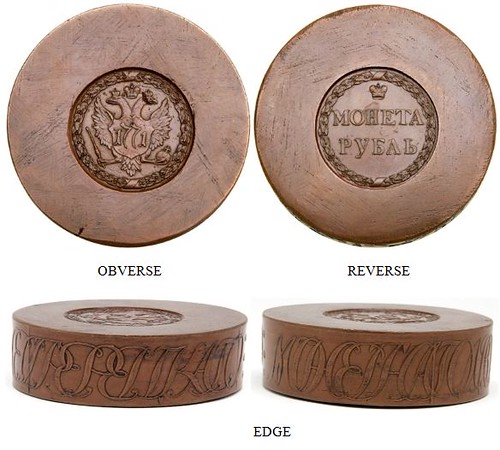
THE PUGACHEV RUBLE
Somewhat related to the Sestroretsk ruble because of their similar devices, the dies used to strike the novodel "Sestroretsk Ruble" were also used to strike this fantasy ruble. It was a well-established practice in Russia to produce restrikes of rare coins upon request of favorites of the reigning ruler, as well as fantasy pieces like this. Both types show identical raised spots from rusty dies indicating that the original dies may have been used after some years of storage. As described in the catalog for the sale mentioned above, this type is colloquially known as the "Pugachev Ruble" because the date 1771 corresponds to the period of the rebellion of Emelyan Pugachev who was a pretender to the throne, in the name of Peter III, and the coin design does not contain the name or monogram of Catherine II.
The Grand Duke Georgii Michailovitch lists this type as item number 28 in his 1885 monograph "A Description of Some Rare Coins in My Collection" in which he described 44 of his rarest and most interesting coins. It is much rarer than the copper "Sestroretsk Ruble" novodel. Catalogued as Novodel Pattern Ruble, 1771. Bitkin-H881 (Rarity-3); Sev-2058; GM-730; Reichel-4627. Silver. 38.3 mm. 18.82 grams. Plain edge. Catherine II. Well struck with semi-reflective surfaces and attractive light toning in silvery gray with some blue highlights on the wreath. NGC graded MS-64 Prooflike. The Dr. Robert D. Hesselgesser Collection, Ex-Irving Goodman Collection, Feb 1991, Lot 465. It realized $51,750 against an estimate of $50,000 - 60,000.
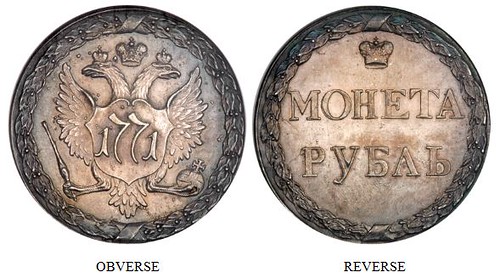
Mentioned in Vladimir Bitkin’s Composite Catalogue of Russian Coins, Part II (1740-1917) is a copper version of this piece. Pictured below, the one designated H1003 is overstruck on a copper 5 kopeck piece. Unique, it is housed in the Hermitage.
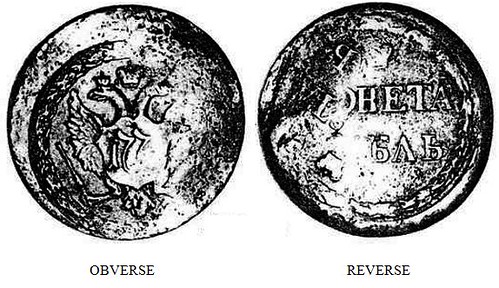
The piece I have is a modern copy (or forgery, if you want to be mean) of the above coin, obtained from an eBay seller in London. Since the “original” is a fantasy piece, as opposed to the Sestroretsk ruble, which was an actual pattern proposed as a regular issue coin, the only real difference is that mine is not made from the original dies. As a type, it is actually a better example, since it has a much better strike. It, too, is struck on a genuine copper 5 kopeck piece.
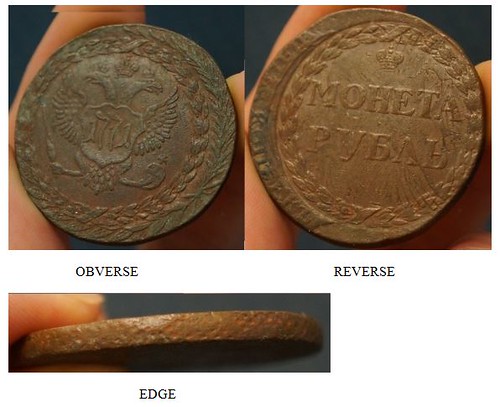
Note that the edge matches that of a copper 5 kopeck piece struck under Catherine II. At the right side of the obverse and the left side of the reverse may be seen the remains of the design of the 5 kopeck coin.
Some would say that collecting modern copies of rare coins is a poor substitute for owning the real thing. In this case, however, I prefer to think of it comparable to owning reproductions of art masterpieces. How else could I own examples of unique coins found only in museums?
(NOTE: This article was derived extensively from material found in The Copper Coinage of Imperial Russia, 1700-1917, by B.F Brekke, and the catalog for Goldberg Coins and Collectibles Inc.'s Pre-Long Beach Sale 31, August 22, 2005.)
THE BOOK BAZARRE
SOUTH KOREA'S 1975 LIBERATION COMMEMORATIVE COIN
Mark Lovmo writes:
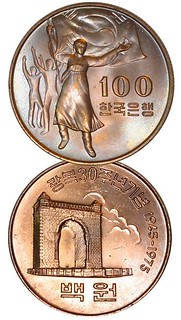 Here is another article in my series on South Korean numismatics.
Here is another article in my series on South Korean numismatics.
It's about the 30th Anniversary of Liberation 100 Won Commemorative Coin (KM-21), South Korea's very first locally-produced commemorative coin, and the country's very first coin to be made, from the beginning to the end of the minting process, entirely in South Korea.
The article highlights a delay that took place in the minting of this coin after the president of the Mint in South Korea attempted to elbow aside this coin in favor of a "memorial coin" for the Korean president's wife, who was killed in an assassination the year before.
I hope readers will enjoy it. ...And linked at the top of the page are my previous articles in the series.
In the nine years from 1965 to 1974, the Korean Mint had gained progressively advanced capabilities in manufacturing coins, ranging from striking coins, to plaster cast engraving, to producing the working dies and pattern coins, among a myriad of other involved processes. By the early 1970s, the Dongnae factory was manufacturing coins with mintages in the hundreds of millions. With an eye towards establishing minting contracts with foreign governments, the Mint incorporated the English title, the “Korea Minting and Security Printing Corporation” (Komsco) in 1971. Its first overseas contracts involved the printing of hundreds of millions of excise stamps for Thailand in May 1970, followed by the minting of 200 million Taiwanese 1 Yuan coins (Y-536) in February 1973.
It was around this time that the government had decided to construct an entirely new, up-to-date facility capable of conducting the full range of manufacturing processes required for a world-class mint operating at peak technical capacity. Construction for this new minting facility was completed on July 4, 1975 in Gyeongsan, near the city of Daegu, in the Southeast of the country. Prior to its official completion in July, the new factory had already begun banknote-printing operations in January.
The country’s coin-manufacturing operations officially transferred from the old Dongnae coin mint (which closed its doors) to the Gyeongsan mint on April 30th that year. With this new facility in place, Komsco aimed for complete self-sufficiency. It was with this objective that the government tasked Komsco with the minting of South Korea’s very first locally made commemorative coins almost as soon as new coin mint came online.
To read the complete article, see:
The 30th Anniversary of Liberation 100 Won Commemorative Coin (1975)
(http://dokdo-research.com/thirtyanniversary.html)
To read the earlier E-Sylum article, see:
MARK LOVMO'S ARTICLES ON SOUTH KOREAN NUMISMATICS
(www.coinbooks.org/esylum_v17n51a27.html)
BELGIUM DEFIES FRANCE WITH WATERLOO COIN ISSUE
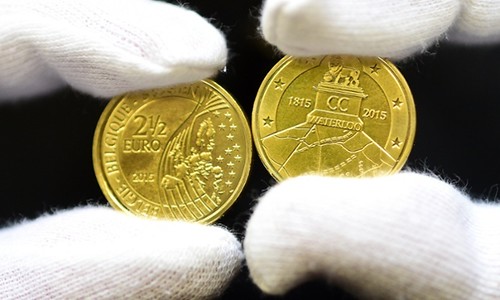
Belgium has begun minting €2.50 coins marking the 200th anniversary of Napoleon’s defeat at Waterloo after France forced it to scrap a €2 coin with the same purpose.
Paris objected to the new Belgian coin, commemorating the French emperor’s defeat by British and Prussian forces, earlier this year, saying it would create tensions at a time when Europe’s unity is under threat.
Belgium was forced to get rid of about 180,000 €2 coins that had already been minted after Paris sent a letter saying they could cause an “unfavourable reaction in France”.
But Belgium has managed to skirt the French protests using a rule that allows eurozone countries to unilaterally issue coins if they are in an irregular denomination.
Napoleon Bonaparte was forced into exile after his grand European ambitions were crushed by the armies of the Duke of Wellington and Gebhard von Blücher at the Battle of Waterloo, which took place on what is now the outskirts of Brussels.
France had said in its initial letter to Belgium that the battle, on 18 June 1815, “has a particular resonance in the collective consciousness that goes beyond a simple military conflict”.
The Belgian finance minister, Johan Van Overtveldt, said the new coins – of which there will be 70,000 – were not being released in a deliberate bid to anger France.
“The goal is not to revive old quarrels. In a modern Europe, there are more important things to sort out,” he said on Monday.
“But there’s been no battle in recent history as important as Waterloo, or indeed one that captures the imagination in the same way.”
The €2.50 coins will be usable in Belgian shops but collectors are expected to snap many of them up. Sold in special plastic bags priced at €6, they show the Lion’s Mound monument that stands at the battlefield, as well as lines indicating the position of the troops.
Several thousand copies of a silver coin – with a face value of €10 but sold at €40 – will also be released.
To read the complete article, see:
Belgium defies France as it mints
€2.50 coin to mark Battle of Waterloo (www.theguardian.com/world/2015/jun/08/belgium-france-coin-battle-waterloo-euro-napoleon)
Philip adds:
I wonder what will happen to the thousands of 2 euros already struck?
The article asked whether France was a “poor loser,” even as it stressed that the €2.50 coin would not be legal tender outside of Belgium, where it is to be sold in plastic bags at a cost of €6.
In Britain, where the 19th-century poet laureate Robert Southey called the Battle of Waterloo “the greatest deliverance that civilized society has experienced” since Charles Martel repelled an Islamic conquest of Europe in 732, the new €2.50 coin aroused similar adulation.
“Well done Belgium beat the French at their own game of finding ways around EU rules, the English should take note!!” Michael Dunn, from Stratford-upon-Avon, wrote on Twitter.
Others were less impressed. On Facebook, Manuel Di Pietrantonio suggested that the value of the dispute was about €2.50.
To read the complete article, see:
Belgium
Commemorates Waterloo With a Coin, and France Is Not Pleased
(www.nytimes.com/2015/06/10/world/europe/belgium-commemorates-waterloo-with-euro-and-france-is-not-pleased.html)
To read the earlier E-Sylum article, see:
BELGIUM'S WATERLOO COIN DESIGN UPSETS FRANCE
(www.coinbooks.org/esylum_v18n11a26.html)
RESEARCHER CLAIMS NAZI GOLD LOOTED BY AMERICAN TROOPS
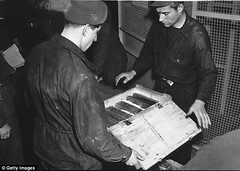 American soldiers looted 25 million pounds in Nazi gold from a secret treasure trove hidden by S.S. overlord Heinrich Himmler in the
closing days of WW2.
American soldiers looted 25 million pounds in Nazi gold from a secret treasure trove hidden by S.S. overlord Heinrich Himmler in the
closing days of WW2.
The gold, money and silver ingots weighing 150lb were hidden in a post office that doubled as a clandestine vault for the Reichsbank in the small German town of Plauen.
It is thought Himmler stashed the treasure in Plauen to be used as fallback funds for S.S. men seeking to escape Allied justice after the collapse of Nazism.
Historical researcher Peter Hentje discovered Himmler's orders about the treasure during a five week search of the U.S. National Archive in Washington. He is making a film about the town's liberation by American soldiers on April 16 1945.
'Originally I was looking for film shot by the RAF on 16mm film which was rare for the day,' said Hentje. 'Then I came across the sensational Himmler document.'
Hentje went on: 'I also found a document detailing the interrogation of a postal official on April 26. He confirmed the almost 900kg of gold, silver and coins which was hidden in the town.'
As well as the Himmler order for the hiding of the loot in Plauen the archive threw up details of Americans shipping the loot out of the town to Frankfurt.
Plauen lay in the east of Germany and had already been assigned by Churchill, Roosevelt and Stalin to the Russians at the Yalta conference earlier in 1945. 'All trace of it was lost after that,' said Hentje. He believes that the Americans considered it a 'reparations payment' and shipped it back to Washington. It is also likely that individual soldiers helped themselves to chunks of the loot.
To read the complete article, see:
How American soldiers looted $50m of Nazi gold: Coins hidden in a post office by Himmler were taken by troops during last days of the
War
(www.dailymail.co.uk/news/article-3114663/Americans-looted-25m-Nazi-gold-Coins-hidden-post-office-Himmler-taken-troops-days-War.html)
THE BOOK BAZARRE
MORE ON THE ONE-CENT MAGENTA STAMP
Yossi Dotan writes:
Regarding the 1856 British Guiana One-Cent Magenta Stamp, there is also a numismatic angle: it was depicted on two coins of the British Virgin Islands issued in 2004 that commemorated the 125th anniversary of the death of Rowland Hill, the inventor of the postage stamp—a red titanium 5-dollar coin (KM#284) and a bimetallic 75-dollar coin composed of a red titanium core in a gold ring (KM#285). The red color of the titanium alludes to the magenta color of the stamp.
Attached are images of the two coins, that of the 75-dollar coin was taken from a sales promotion by the Pobjoy Mint.
The E-Sylum of October 23, 2005 included a description of the coins. They were listed in my book Watercraft on World Coins, Volume II: America and Asia, 1800-2008 because of the ship on the stamp. She is the vessel that was shown on British Guiana's colonial badge.
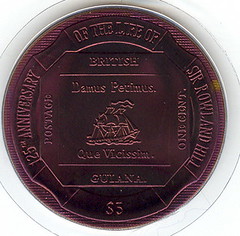
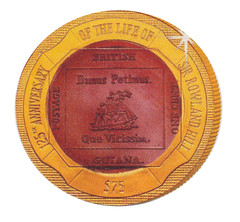
 As a
boy in Queens with a couple of stamp albums, Stuart Weitzman stared at the blank spaces for two of the world’s most famous stamps — spaces
that he figured he would never fill. One was for an 1856 One-Cent Magenta from British Guiana, and there is only one One-Cent Magenta in
all the world.
As a
boy in Queens with a couple of stamp albums, Stuart Weitzman stared at the blank spaces for two of the world’s most famous stamps — spaces
that he figured he would never fill. One was for an 1856 One-Cent Magenta from British Guiana, and there is only one One-Cent Magenta in
all the world.
Mr. Weitzman, 73, pretty much gave up stamp collecting in his late teens and went on to achieve notoriety and wealth designing shoes — strappy gladiator sandals, sultry thigh-high boots and dozens of others made from everything from cork to Lucite, even 24-karat gold.
But Mr. Weitzman never forgot about the One-Cent Magenta, and he fulfilled his boyhood dream last year when he bought the stamp anonymously at auction for $9.5 million.
His identity as the buyer was revealed on Thursday, the same day the stamp went on display at the National Postal Museum in Washington. Mr. Weitzman has lent the stamp to the museum for two and a half years.
So for nearly a year, the man behind the Nudist, a sandal with thin straps and pin heels, has owned a stamp that is barely big enough to cover a birthmark on a supermodel.
“The stamp looked so tiny,” he added.
To some philatelists, the One-Cent Magenta is the “Mona Lisa” of stamps, perhaps not inscrutable but certainly incomparable. Die-hard collectors tend to be more interested in the back than the front, which has an image of a schooner and a Latin motto that is usually translated as “We give and we take in return.” It bears the initials from a clerk at the post office where it was originally sold and from past owners. There is even an unusual-looking star, yet another mark of a past owner.
Unlike the famous Inverted Jenny, the 1918 United States stamp that was mistakenly printed with an upside-down biplane known as a Jenny, the One-Cent Magenta is not just rare, it is unique. There are 100 Inverted Jennies. As Mr. Weitzman learned as a child, no other One-Cent Magentas are known to exist, and until it went on a tour arranged by Sotheby’s before the sale last year, it had not been seen in public since the 1980s.
David Sundman adds:
The buyer also bought my brother Donald Sundman's Jenny Invert plate block. Don owns Mystic Stamp Company in Camden, New York.
To read the complete article, see:
A
Stamp, Tiny and Rare, Fulfills a Boyhood Dream
(www.nytimes.com/2015/06/05/nyregion/stuart-weitzman-to-display-one-cent-magenta-stamp-that-fulfilled-boyhood-dream.html)
To read the earlier E-Sylum articles, see:
NOTES FROM E-SYLUM READERS: JUNE 7, 2015 : 1856 British Guiana One-Cent Magenta
Stamp Displayed (www.coinbooks.org/esylum_v18n23a10.html)
MORE STAMPS ON COINS (www.coinbooks.org/esylum_v08n45a19.html)
MEDALS ON STAMPS
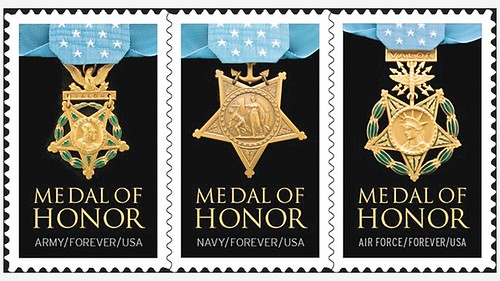
I collect medals on stamps. I used to buy these from numismatic author and fellow Rittenhouse Society member George Fuld. He and his wife owned a stamp store at one time. Unfortunately he sold the stamp business before he died. I don't have that privilege any more.
Last week the U.S. Postal Service launched a third medal-on-stamp issue in their Medal of Honor stamps honoring recipients of the country's highest military honor. This time for service. during the Vietnam War,
These stamp “sheets" are a folded panel, half on one side, half on the other, what the Post Office calls a "Prestige Folio.”
Similar stamps were issued previously for World War II service in 2013, and Korean War in 2014. All stamps in the series have a border of photos of recipients of the medal. Two different medals were illustrated -- one for the Army and one for the Navy. -- in the first two issues.
The stamps issued this week are nondenominational Forever (49c) in a folded pane of 24 stamps. Twelve stamps appear on on each half of the folded sheet, That folded concept, in addition to photos of America’s heroes, make this series distinctive.
There are three different medals this time, in addition to the Army and Navy versions, the Air Force Medal of Honor is shown on a third stamp. Medals are illustrated in full color on a black background.
In the border around the twelve stamps are photographs of twenty recipients of the medal, forty on the full pane. Most are bare-headed, a few are shown with a hat or headgea of their military unit. Their names are printed on the back of the panel identifying each.
First Day of Issue was May 25 in Washington. DC.
Since the medals sown on the stamps are of such a high rank military deoration, it is the highest form of medal design and manufacture as well. All three medals are of unusual shape, trimmed in silhouette with pierced openwork. Two contain green enamel in the wreath behind the five-pointed star around the center device.
I remember seeing these medals being made when I worked for Medallic Art Company in New York City. Piercing out that openwork around the eagle on the Army Medal or the arrows on the Air Force Medal was particularly critical.
Making the pad of star-encrusted blue ribbon was also difficult. Every medal, every component had to be absolutely prefect. The recipients of the highest honor deserved the very best!
Kudos to the Post Office Service for this highly innovative and creative stamp issue. You have honored our heroes and you have also honored this medal. All three versions.
To read the complete article, see:
Medal of
Honor series adds Air Force medal in pane of 24
(www.linns.com/en/insights/us-stamps-and-postal-history/2015/05/medal-of-honor-series-adds-air-force-medal-in.html)

ZIMBABWE COMPLETING PHASING OUT OF ITS OLD CURRENCY
Zimbabwe is phasing out its local currency, the central bank says, formalising a multi-currency system introduced during hyper-inflation.
Foreign currencies like the US dollar and South African rand have been used for most transactions since 2009.
Local dollars are not used except high-denomination notes sold as souvenirs. But from Monday, Zimbabweans can exchange bank accounts of up to 175 quadrillion (175,000,000,000,000,000) Zimbabwean dollars for five US dollars.
Higher balances will be exchanged at a rate of Z$35 quadrillion to US$1.
The highest denomination was a $100 trillion Zimbabwean dollar note.
A four-year unity government, that ended in 2013 with President Robert Mugabe's re-election, helped stabilise the economy but it still faces huge challenges.
One of the problems has been the shortage of coins that kept prices high as retailers often rounded them up and shoppers were given change in sweets or pens.
Over the last six months, the central bank has introduced about $10m (£6.4m) worth of "bond coins" into circulation, but they have not been popular with consumers who fear that it is the first step in the re-introduction of the Zimbabwe dollar.
To read the complete article, see:
Zimbabwe dollars phased out (www.bbc.com/news/world-africa-33105400)
Zimbabwe in 2009 abandoned its currency for a system dominated by the U.S dollar and the South African rand after inflation hit 230 million percent. Back then, even street hawkers refused to accept a $100 trillion dollar note that was issued.
Starting Monday, stacks of Zimbabwean bills that might still be kept by Zimbabweans can be exchanged for U.S dollars. The offer is part of what the central bank says is an overdue plan to phase out the currency entirely.
Some people in Harare, Zimbabwe's capital, said they disposed of their Zimbabwean dollars long ago.
"I used it as garden manure," said Isaac Mutezowepasi, a street vendor. "Why would I have kept that dirt?"
Others said they still have heaps of old dollar notes at home, but won't respond to the government offer.
"I am keeping them for my grandchildren to see. Plus I know I will get more for them in future because these Zimdollars are going to be in demand," said Tendai Nyaundi, a graphic designer.
On e-Bay on Friday, five banknotes of 100 trillion Zimbabwean dollars were being sold for $159. Another e-Bay post put five banknotes of $100 trillion at $173.99.
To read the complete article, see:
Zimbabwe allows banknotes from bad
old days of hyperinflation to be exchanged for US dollars
(www.startribune.com/count-the-zeroes-zimbabwe-allows-old-banknote-exchange/307111091/)
Although people have primarily been using the US dollar for years, many have been holding on to their Zimbabwean dollars, partly because there has been uncertainty as to whether or when there might be a return to the Zimbabwean dollar.
Chitiyo says one big reason for the Central Bank's move is to reassure people that the Zimbabwean dollar is not about to return any time soon.
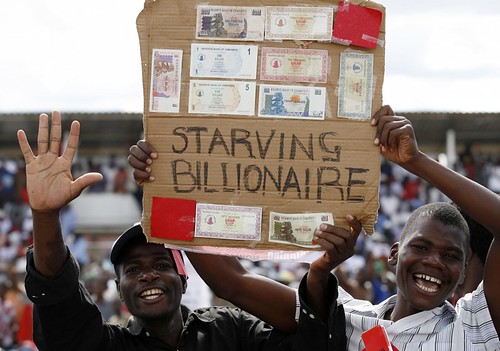
To read the complete article, see:
What can you buy for $100
trillion in Zimbabwe? Not even a candy bar
(www.pri.org/stories/2015-06-12/what-can-you-buy-100-trillion-zimbabwe-not-even-candy-bar)
THE 1950 PAKISTAN 100 RUPEES HAJ NOTE
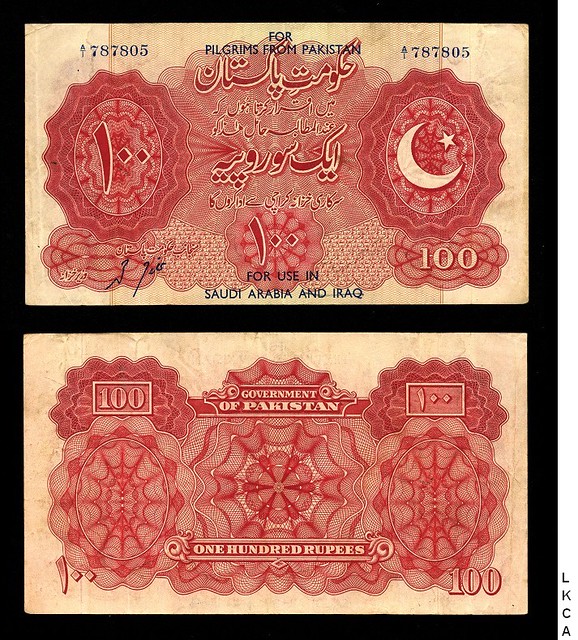
It is a great pleasure to present this absolutely incredible piece, certainly one of the rarest world notes we have ever offered and the only I have ever seen. Overprint "FOR/PILGRIMS FROM PAKISTAN/FOR USE IN/SAUDI ARABIA AND IRAQ". Signature Ghulam Mohammad.
The cross appeal of this wonder is blatantly clear. This Standard Catalog plate note is the first Haj note, not the Saudi Arabia 10 Riyals as some believe. Research by Peter Symes indicates that "the Haj notes were not legal tender in Pakistan, but...could be used in Saudi Arabia to purchase Saudi riyals and be remitted to Pakistan via the usual channel of the Saudi Arabian banks...the introduction of the 100-rupee Haj note was an outstanding success for the government.
In 1949, the year before the introduction of the Haj note, Pakistani notes to the value of Rs. 28,045,308 were repatriated from Saudi Arabia. In 1950, following the introduction of the Haj notes, only Rs. 11,186,100 were repatriated. This indicated a great saving for the government and the notes also proved popular with the pilgrims. However, it was seen that there was a need for a lower denomination Haj note, as the sole availability of such a large denomination note as the 100-rupee...often caused some inconvenience." Small spindle slit at left center as typical for notes of this region. For accuracy, light spot at right center does not significantly impact this overall problem free original with vivid color. Most likely equals or surpasses the rarity of the legendary Palestine issued 100 Pounds. This note represents an opportunity that may not be repeated for decades, if ever.
Joel Shafer adds:
I also recently made the following observations:
1) Historic impact. This piece launched several other Haj types much better known including Saudi Arabia Standard Catalog #1 (scarce in its own right) as well as later Pakistan issues. Relatively few pieces hold the status of starting conceptually new issues for several different countries.
2) In some ways by contrast with this history, this type's relative obscurity. I would venture that many advanced hobbyists are unaware of the existence of this type, not to mention how rare it is! It is intriguing how some excessively rare types hold iconic status (the Palestine 100 Pounds) while others seem to slip through the cracks, thereby presenting an even more phenomenal opportunity.
To read the complete lot description, see:
R1 100 Rupees ND (1950)
(www.lynknight.com/ShowAuctionDetails.Asp?auction_Id=252141)
SELECTIONS FROM THE SPINK WORLD BANKNOTES SALE
Lot 66: Government of India, Burma, 1000 rupees
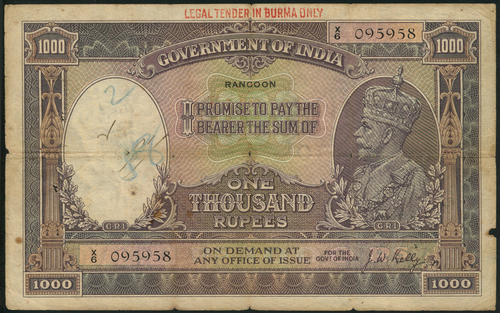
Government of India, Burma, 1000 rupees, Rangoon, ND (1937), serial number X6 095958, brown and multicolour, portrait King George V at right ornate columns at left and right, reverse, oxen at centre with mountains and palm trees in background (LNZ GOI B4a, Pick not listed) numerous folds and pinholes, graffiti, nicks in border, red LEGAL TENDER IN BURMA ONLY, several bank stamps on reverse, otherwise good, extremely rare
To read the complete lot description, see:
Auction: 15028 - World Banknotes Lot: 66
(www.spink.com/lot-description.aspx?id=15028000066)
Lot 71: Fraudulent Claim of Hereditary Lands of Nova Scotia
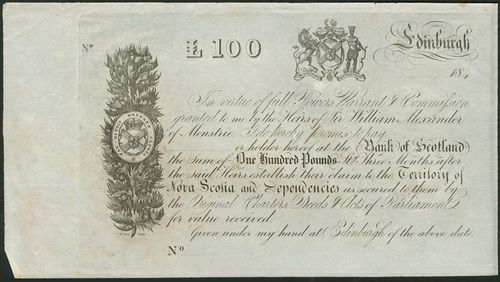
Fraudulent Claim of Hereditary Lands of Nova Scotia, unissued £20, 184[-],£50, 184[-], and £100, 184[-], black and white, Royal Coat of Arms at left, Arms of the Alexander's of Menstrie top centre all with foxing and burred edges otherwise about extremely fine to uncirculated (3)
To read the complete lot description, see:
Auction: 15028 - World Banknotes Lot: 71
(www.spink.com/lot-description.aspx?id=15028000071)
Lot 143: Bank of Ethiopia, 100 thalers 1932
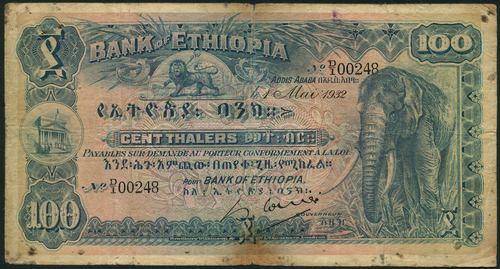
Bank of Ethiopia, 100 thalers, 1 May 1932, serial number D/1 00248, blue on multicolour, African Elephant at right, arms at top centre (LNZ BOE B5a, Pick 10), pinholes top right, about fine
To read the complete lot description, see:
Auction: 15028 - World Banknotes Lot: 143
(www.spink.com/lot-description.aspx?id=15028000143)
Lot 146: Falkland Islands, £1 1920
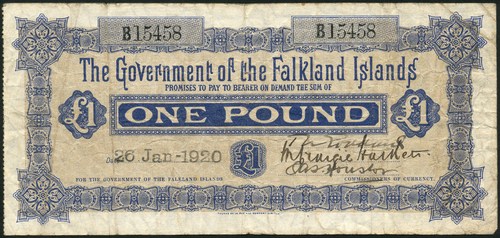
Government of the Falkland Islands, £1, 26 January 1920, serial number B15458, blue on tan underprint, value at centre, left and right, three manuscript signatures at low right (Pick A3 for type, LNZ GFI B4 for type), no holes or tears, and good paper strength, fresh and original good fine, an extremely rare note with an unlisted date, exceptional
To read the complete lot description, see:
Auction: 15028 - World Banknotes Lot: 146
(www.spink.com/lot-description.aspx?id=15028000146)
Lot 216: Farsi Overprint on German Marks
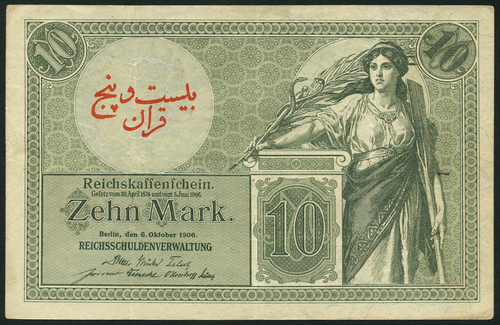
Farsi Overprint on German Marks, 25 kran on 10 mark, 1906 (1916-17), serial number J.Nr2737626, dark green, woman with oar at right, red farsi overprint in watermark area and on reverse (Pick M2), fresh and original good very fine, rare
To read the complete lot description, see:
Auction: 15028 - World Banknotes Lot: 216
(www.spink.com/lot-description.aspx?id=15028000216)
MORE SELECTIONS FROM PRESIDENTIAL AUCTION #85
Lot 375: Duchesse Du Maine Order of the Honey Bee Medal in Gold
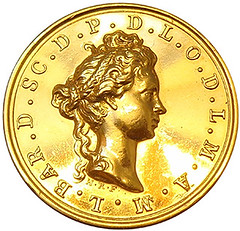
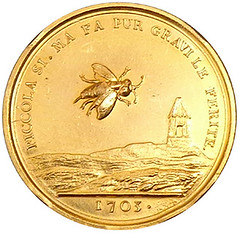
DUCHESSE DU MAINE ORDER OF THE HONEY BEE MEDAL IN GOLD, 1703. Gold. Brilliant Uncirculated with proof-like lightly hairlined surfaces. 28.5 mm, 14.4 grams. Obverse: Bust of Louise Bénédicte de Bourbon, Duchess of Maine facing right, legend surrounding: L.BAR.D.SC.D.P.D.L.O.D.L.M.A.M [Louise, BARonne De SCeaux, Dictatrice Perpétuelle De L’Ordre De La Mouche À Miel- Louise (Baroness de Sceaux, Perpetual dictator of the Order of the Honey Bee)], Below bust: H.R.F. (Henri Roussel Fecit) Reverse: Prominent Honey Bee in the foreground with a bee hive in the distance, legend surrounding: PICCOLA SI MA FA PUR GRAVI LE FERITE. (She is small, yes, but nonetheless gives cruel wounds).
No original examples of the medals are known to exist. In the 19th century, restrikes were also struck in silver, copper, and coppergilt; presumably with the original dies. The silver examples are quite rare. This medal has two cornucopias straddling the number 1 on the edge, indicating an 1880’s strike of high gold content. This is the only known example in gold extant which matches the composition and appearance of the original medals.
Lot 384: Benjamin Franklin Terra Cotta Medallion
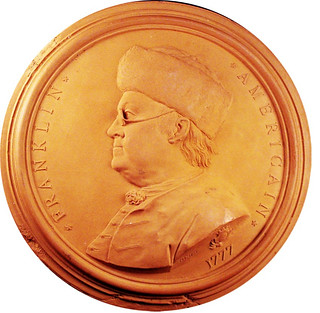
BENJAMIN FRANKLIN WITH SPECTACLES AND FRANKLIN AMERICAIN LEGEND -EXCESSIVELY RARE AND DESIRABLE TERRA COTTA MEDALLION BY JEAN BAPTITISTE NINI, 1777. Storelli LXIII. 118 mm (approximate measurement outside display case). Hand-beveled along reverse rim. Bust of Franklin in Fur cap facing left, wearing spectacles, with legend surrounding: *FRANKLIN* *AMERICAIN*, below bust the date: 1777, surrounded by intrinsic frame. Under the truncation of the bust is a coat of arms with a hand holding a lightning rod, and a vertical lightning bolt; to left incuse artist’s signature: NINI F, to right: 1777.
In addition to the “common” fur cap variety, Jean Baptiste Nini created several varieties of his Franklin terracotta medallions, including two varieties with Franklin wearing a Phrygian Liberty cap, Franklin bare headed with a star above his head, large format with Franklin bare headed (in 1779), and this variety with Franklin wearing spectacles with legend surrounding. Franklin invented bifocals and the lightning rod seen in this medallion’s design which honors Franklin as inventor and scientist.
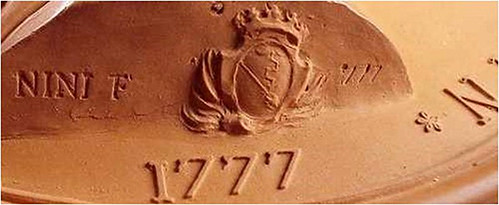
Lot 385: Benjamin Franklin With Spectacles Medallion
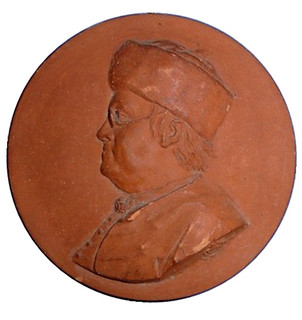 BENJAMIN FRANKLIN WITH SPECTACLES - RARE TERRA COTTA MEDALLION BY JEAN BAPTISTE NINI, 1777.
Storelli LXIV, Greenslet GM-6. 93.5 mm x 8mm.120.8 g. Very slight beveling along rear edge. Bust of Franklin in Fur cap facing left,
wearing spectacles; under the truncation of the bust is a coat of arms with a hand holding a lightning rod, and a vertical lightning bolt,
to left incuse artist’s signature: NINI F, to right: 1777. Storelli describes this medallion as similar to the preceding Storelli LXIII but
“par l’absenced’encadrement et de legend” (missing the legends and framing). As explained in the preceding lot, the relative size and
design of this smaller medallion appears to match the interior bust of Franklin seen on Storelli LXVIII. This bust, like Storelli LXIII, is
entirely different than the bust seen on the common fur cap variety.
BENJAMIN FRANKLIN WITH SPECTACLES - RARE TERRA COTTA MEDALLION BY JEAN BAPTISTE NINI, 1777.
Storelli LXIV, Greenslet GM-6. 93.5 mm x 8mm.120.8 g. Very slight beveling along rear edge. Bust of Franklin in Fur cap facing left,
wearing spectacles; under the truncation of the bust is a coat of arms with a hand holding a lightning rod, and a vertical lightning bolt,
to left incuse artist’s signature: NINI F, to right: 1777. Storelli describes this medallion as similar to the preceding Storelli LXIII but
“par l’absenced’encadrement et de legend” (missing the legends and framing). As explained in the preceding lot, the relative size and
design of this smaller medallion appears to match the interior bust of Franklin seen on Storelli LXVIII. This bust, like Storelli LXIII, is
entirely different than the bust seen on the common fur cap variety.
The molds for Storelli LXIV were later used by Balon to make aftercasts in the late 19th century. The aftercasts were not created using the clay at Château Chaumont and are smaller in diameter with a slightly smaller design as well as thicker and heavier in weight than seen on this piece. More than anything, the Balon aftercasts have a different “feel” and are more granular than the silky feel of this piece made from the fine clay at Château Chaumont.
This small terra cotta medallion with Franklin wearing spectacles is excessively rare, with less than a dozen examples known - the majority of which are likely Balon aftercasts. The medallion has a uniform rich red/brown coloration with a few small areas of disturbance seen on the shoulder, fold of the coat, lapel and highest point of the fur cap which could be professionally restored. Still, overall an excellent example of great rarity. The Ford example sold in a Stack’s May 2006 auction for $11,500. $7000+
For more information, see:
www.coinbooks.org/%20http://www.maineantiquedigest.com/custom/presidential.htm
To read the earlier E-Sylum article, see:
SELECTIONS FROM PRESIDENTIAL AUCTION #85
(www.coinbooks.org/esylum_v18n23a26.html)
OLD SAN FRANCISCO MINT BUILDING ATTRACTS HOMELESS
When I walked from the Chronicle to Uber on Market Street last week, I smelled urine on every block — and more than once. San Francisco’s Main Street is shameful. So if the Supes want to warn people about social phenomena that are painfully obvious, how about this warning for tourists?
WARNING: Parts of San Francisco smell like a toilet.
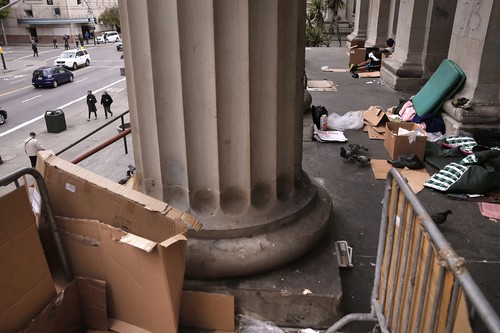
The homeless have set up living on the steps of the old
United States Mint building in San Francisco, as seen on May, 28, 2015.
To read the complete article, see:
Warning: San Francisco smells like a
toilet (http://blog.sfgate.com/djsaunders/2015/06/09/warning-san-francisco-smells-like-a-toilet/)
